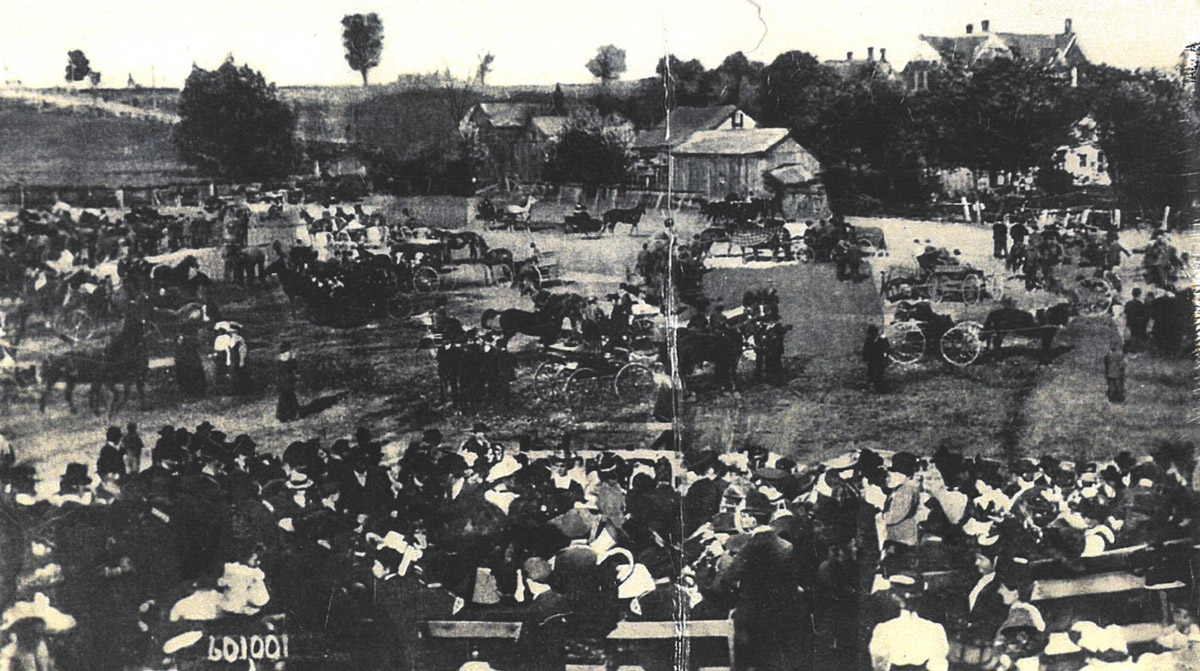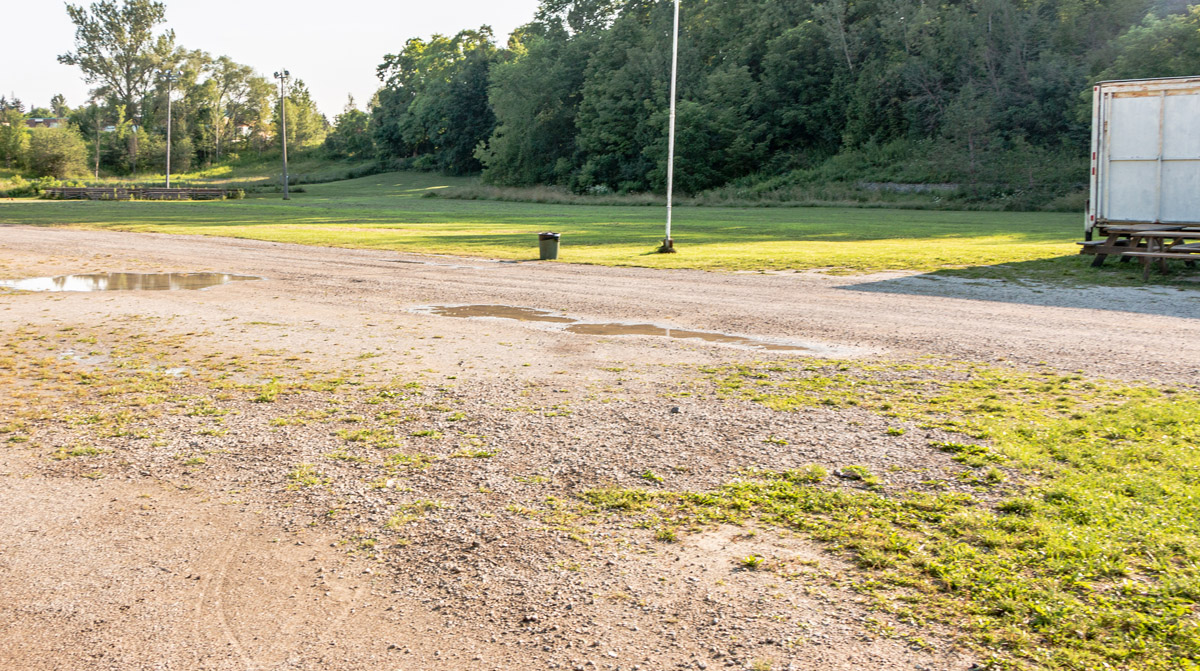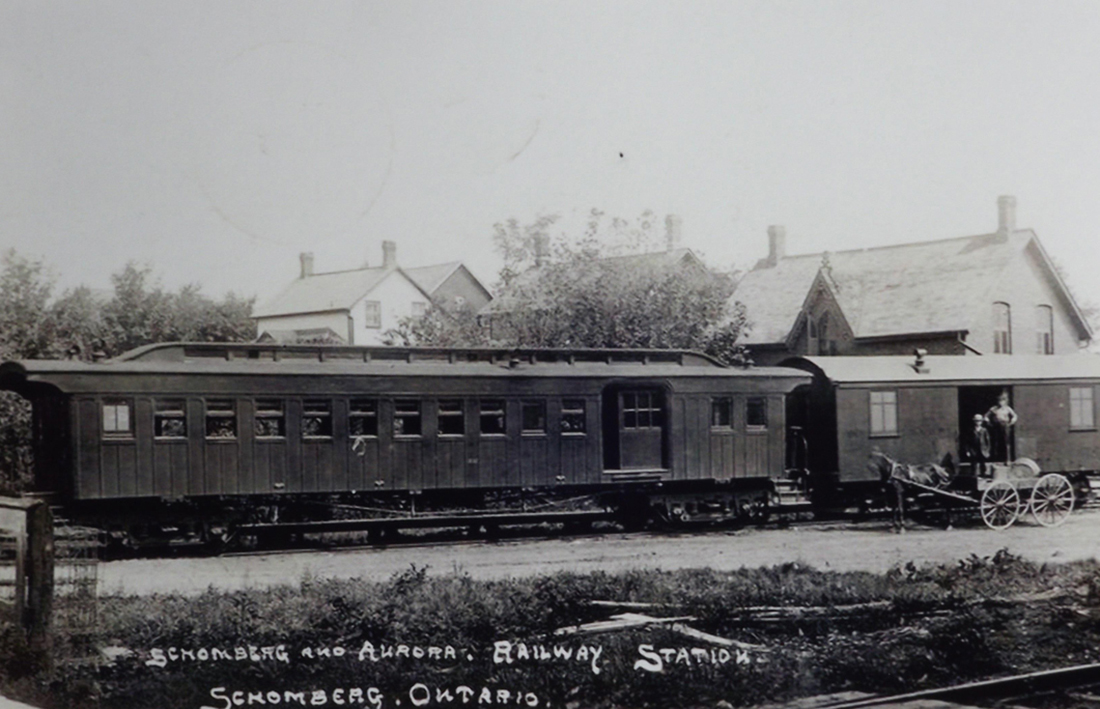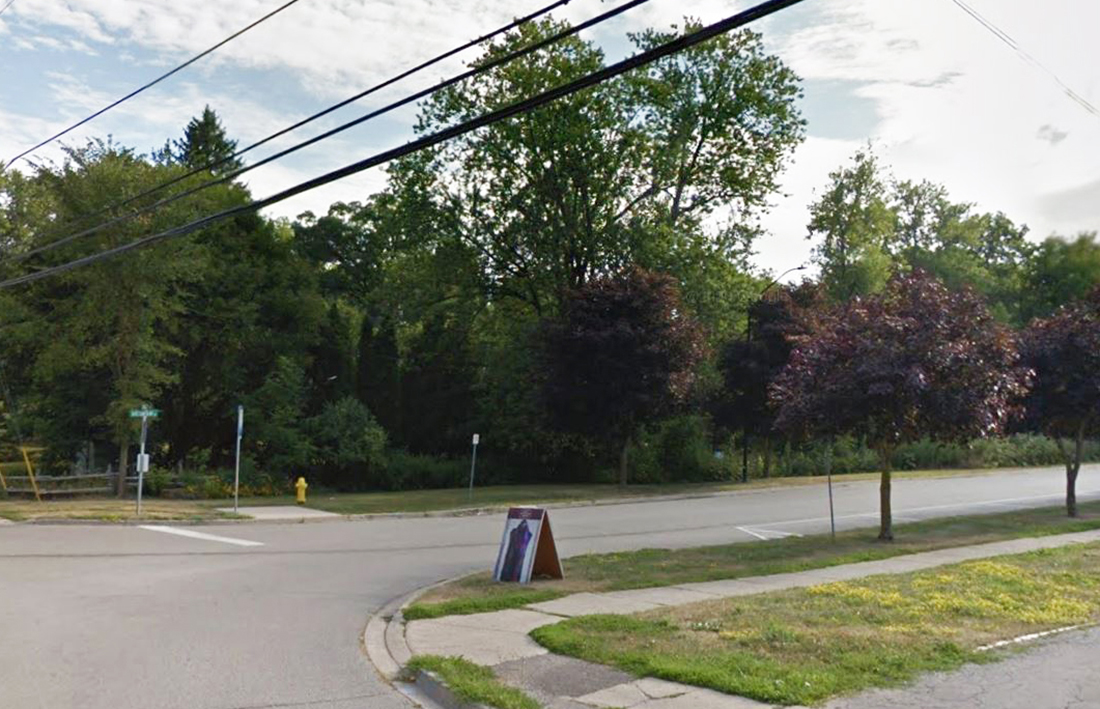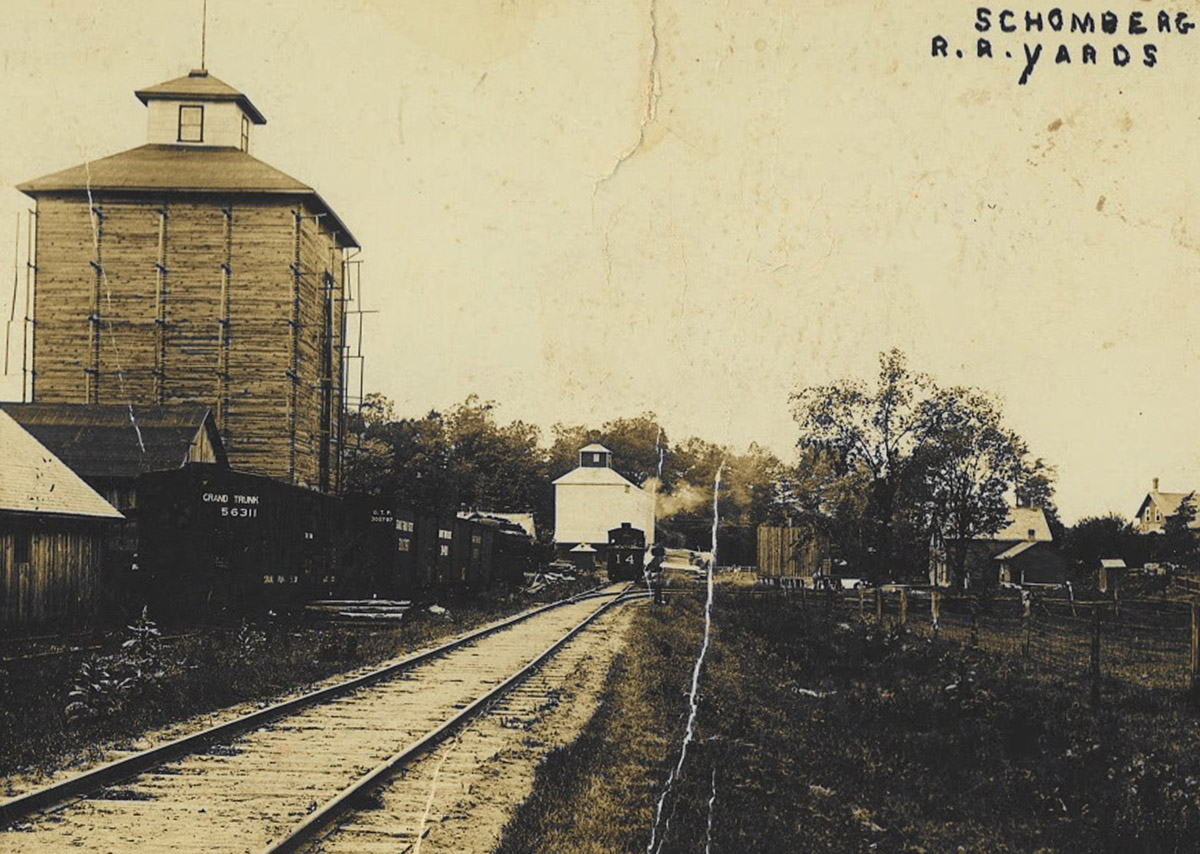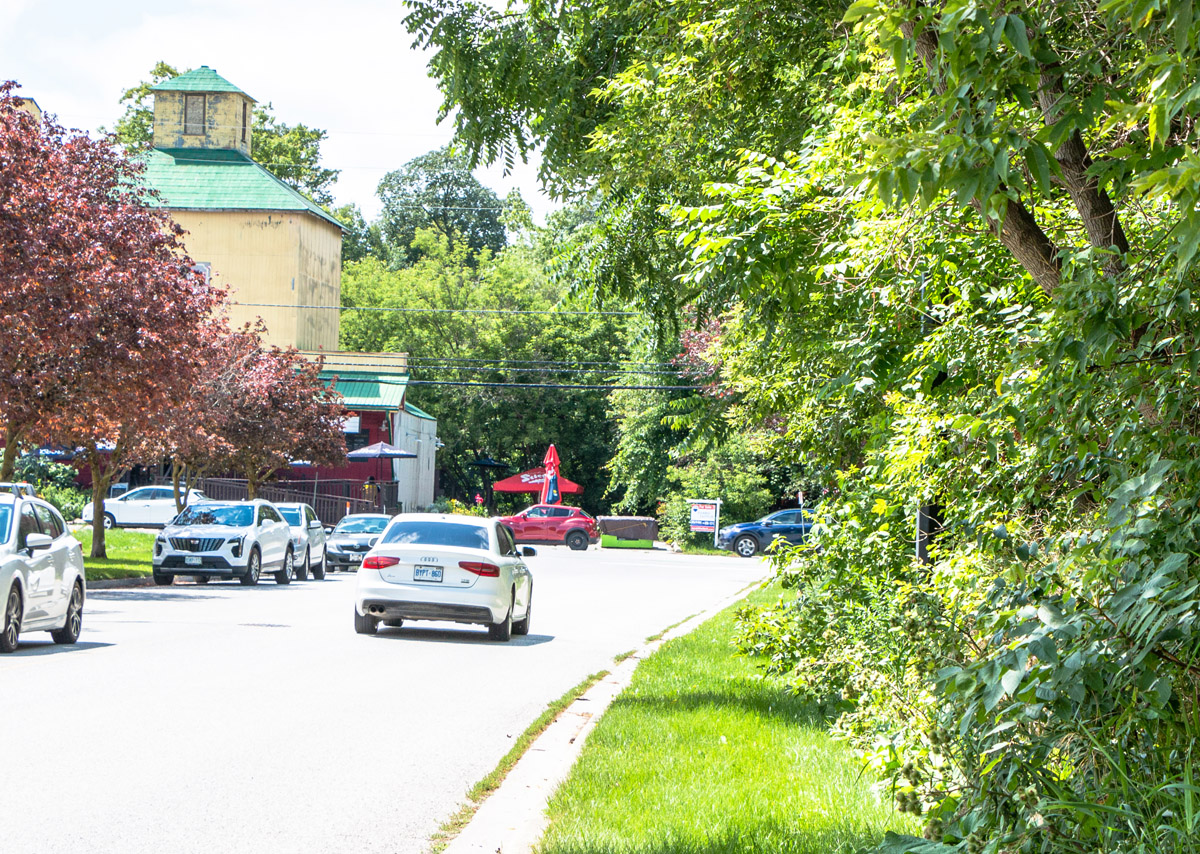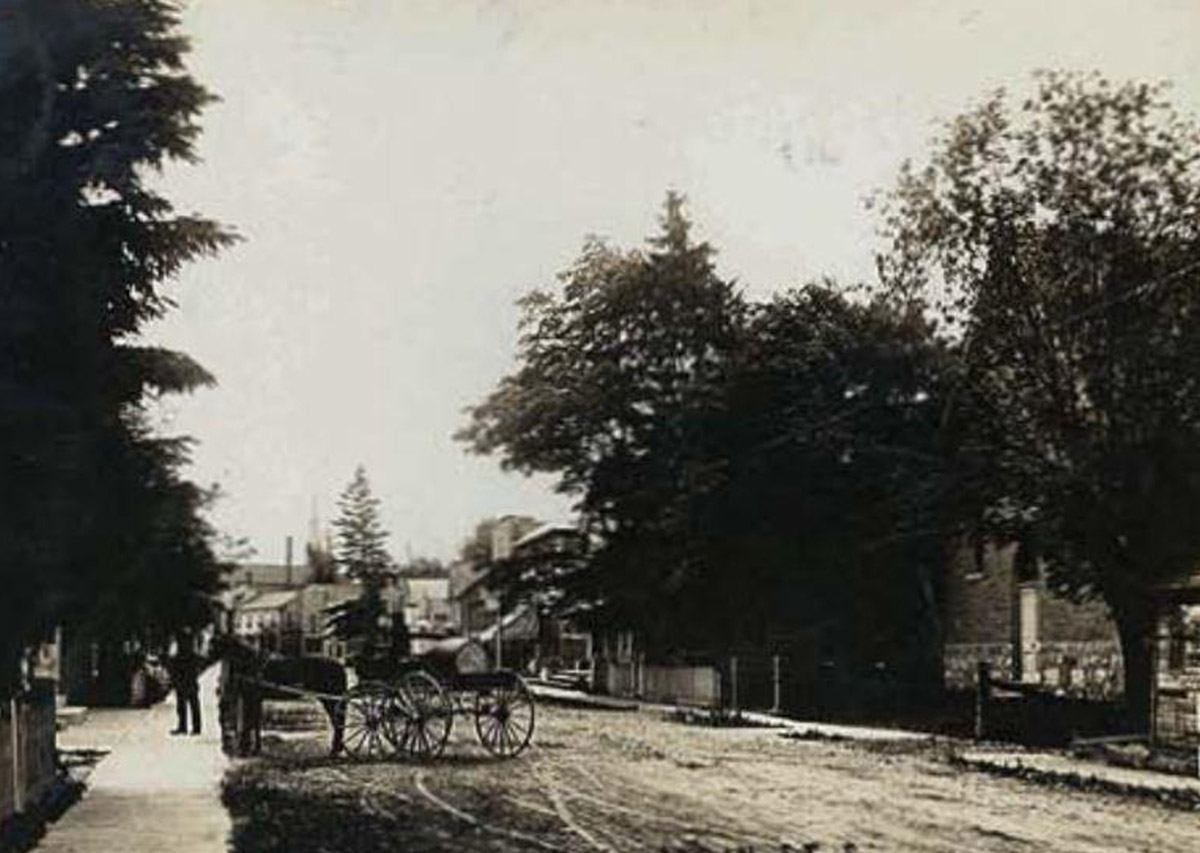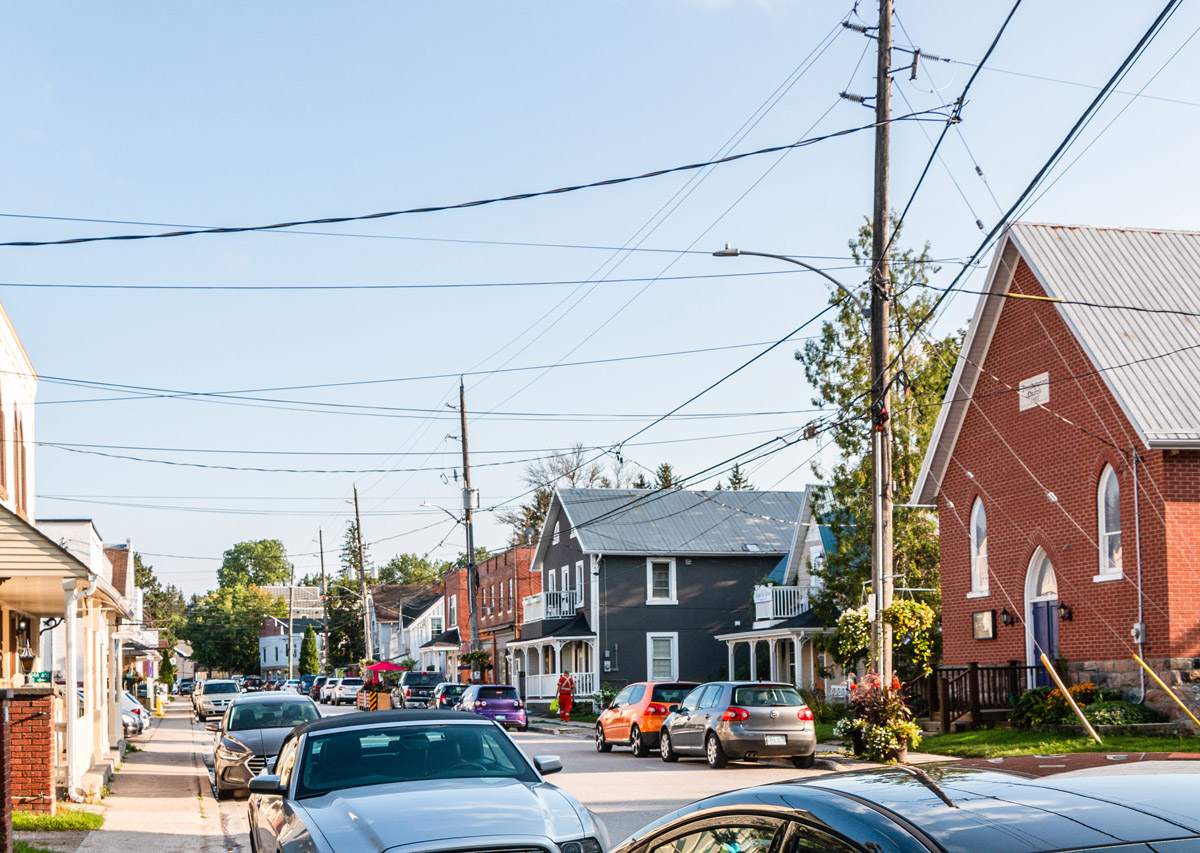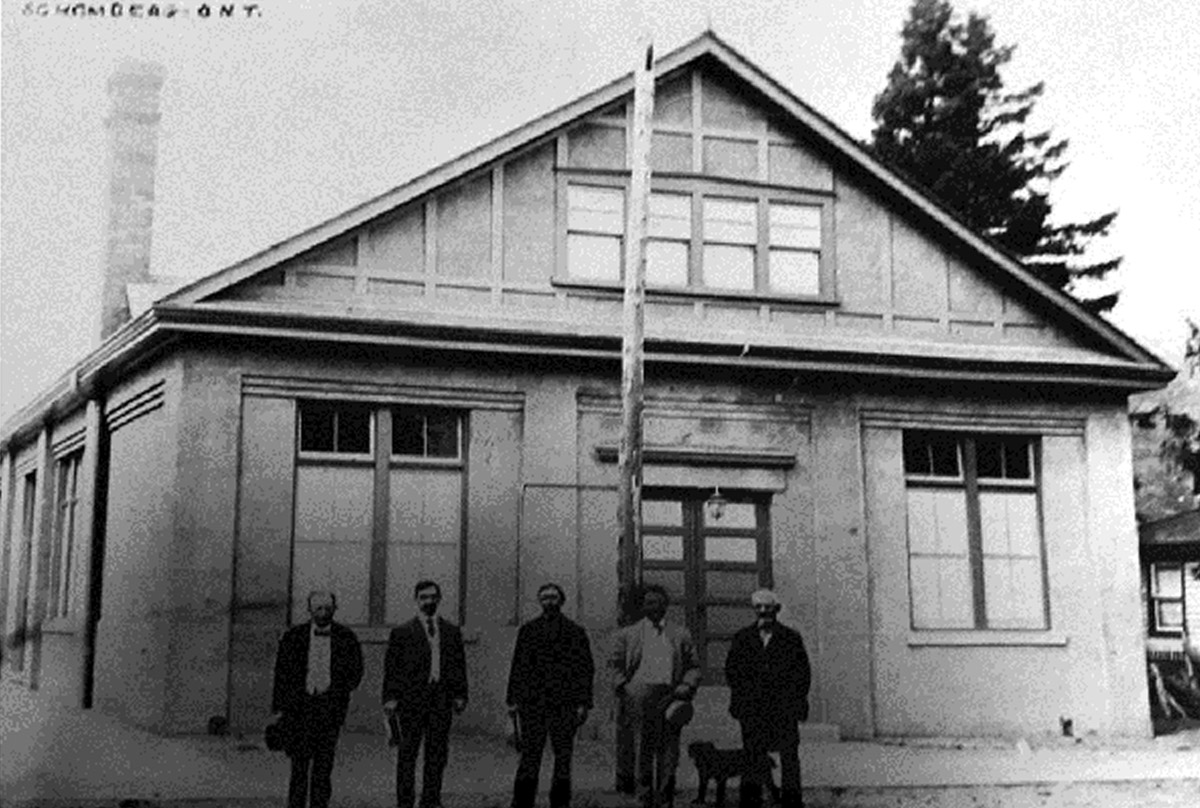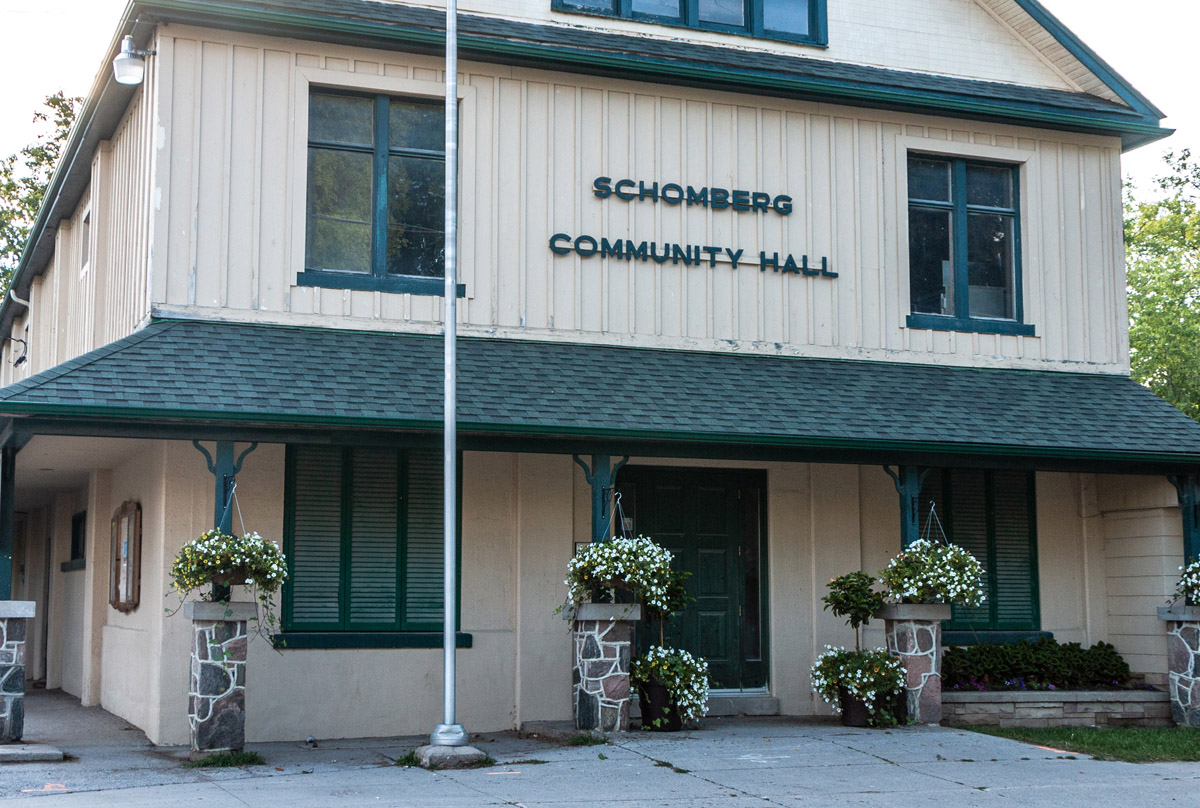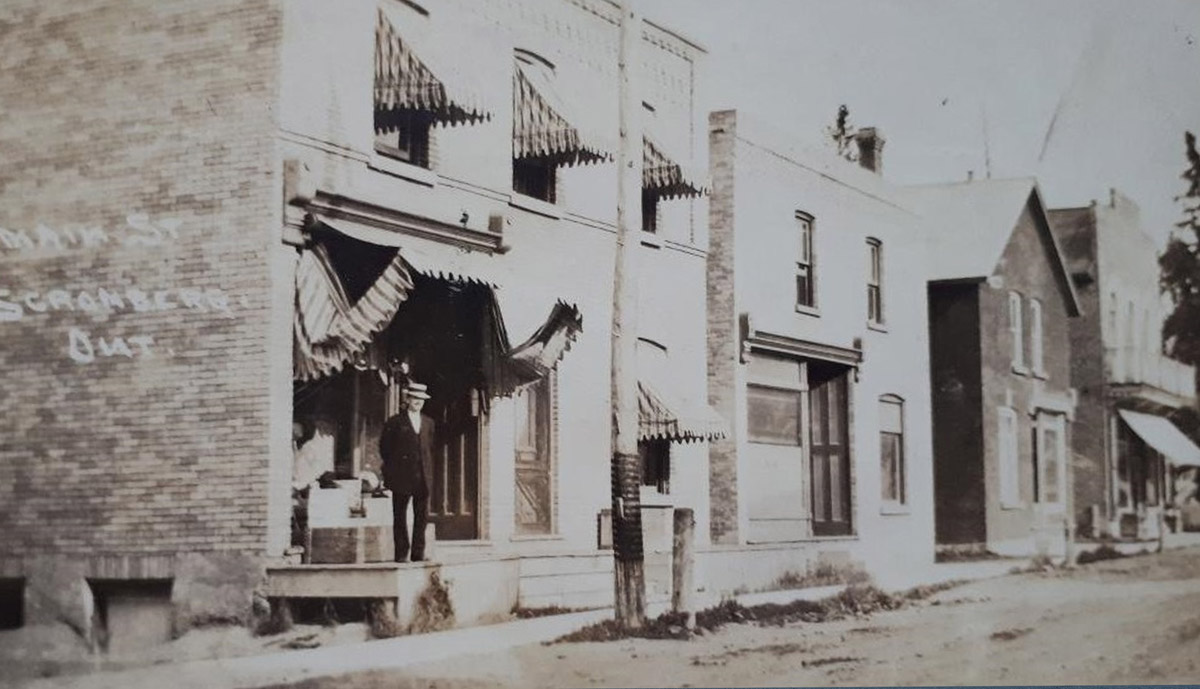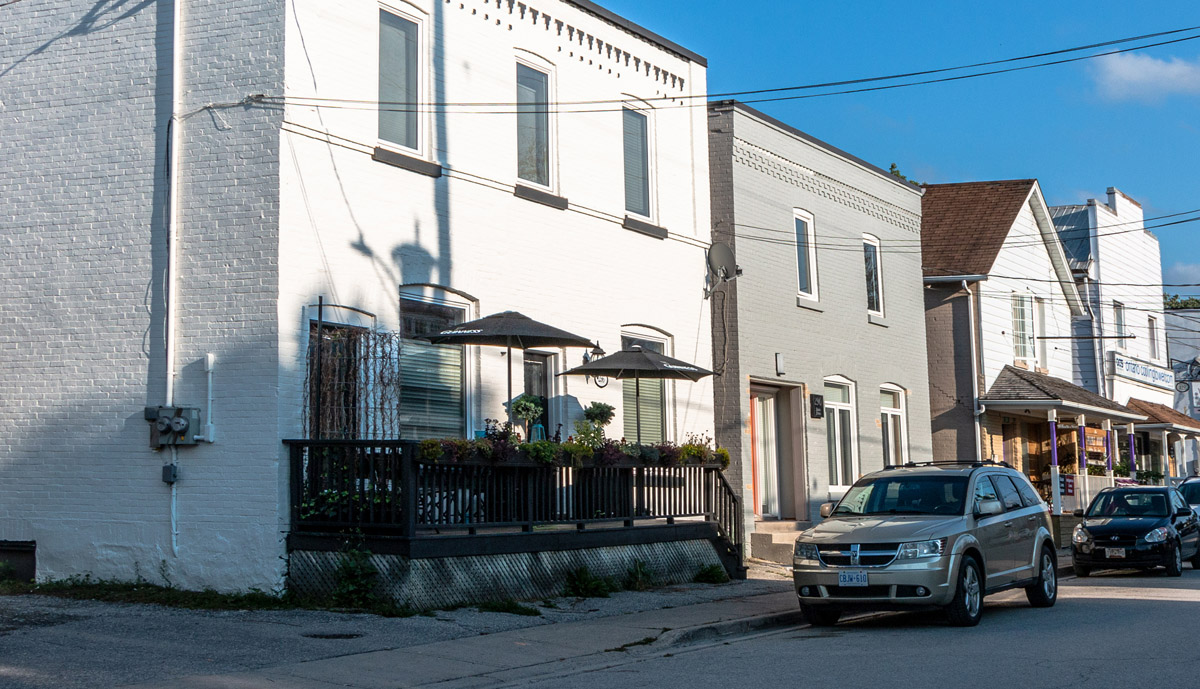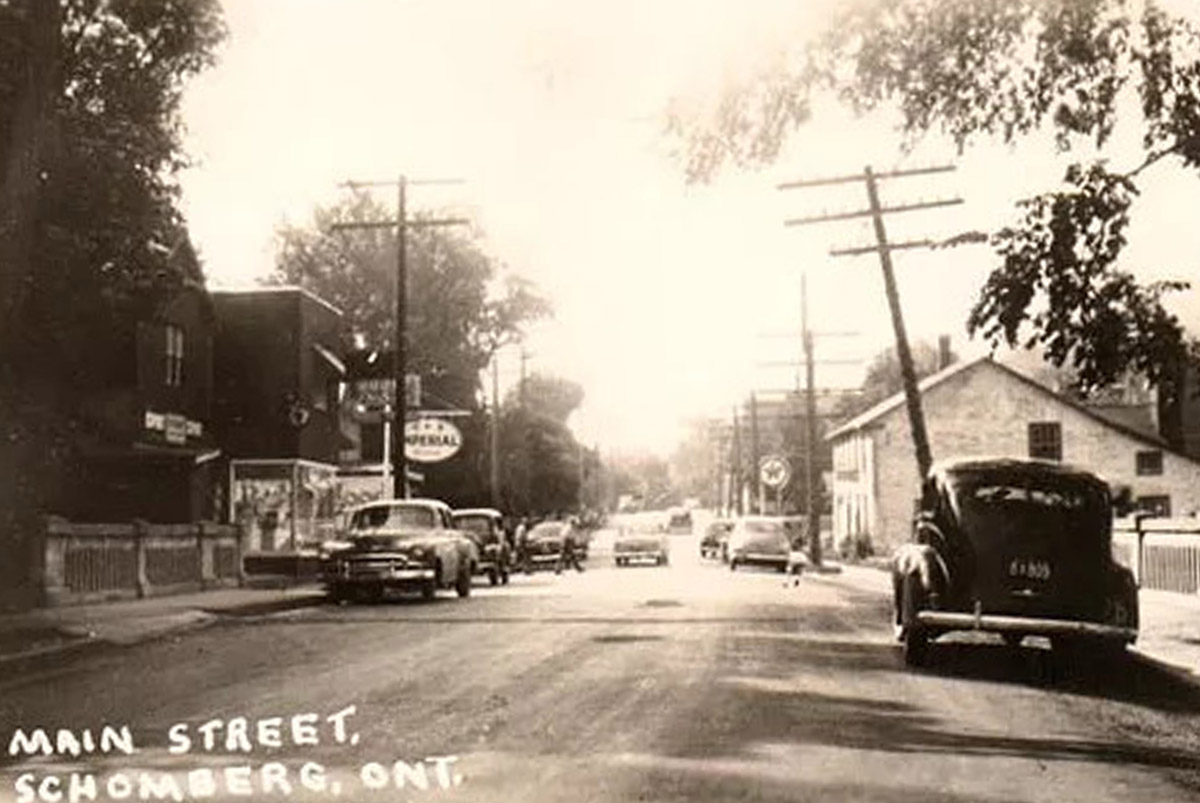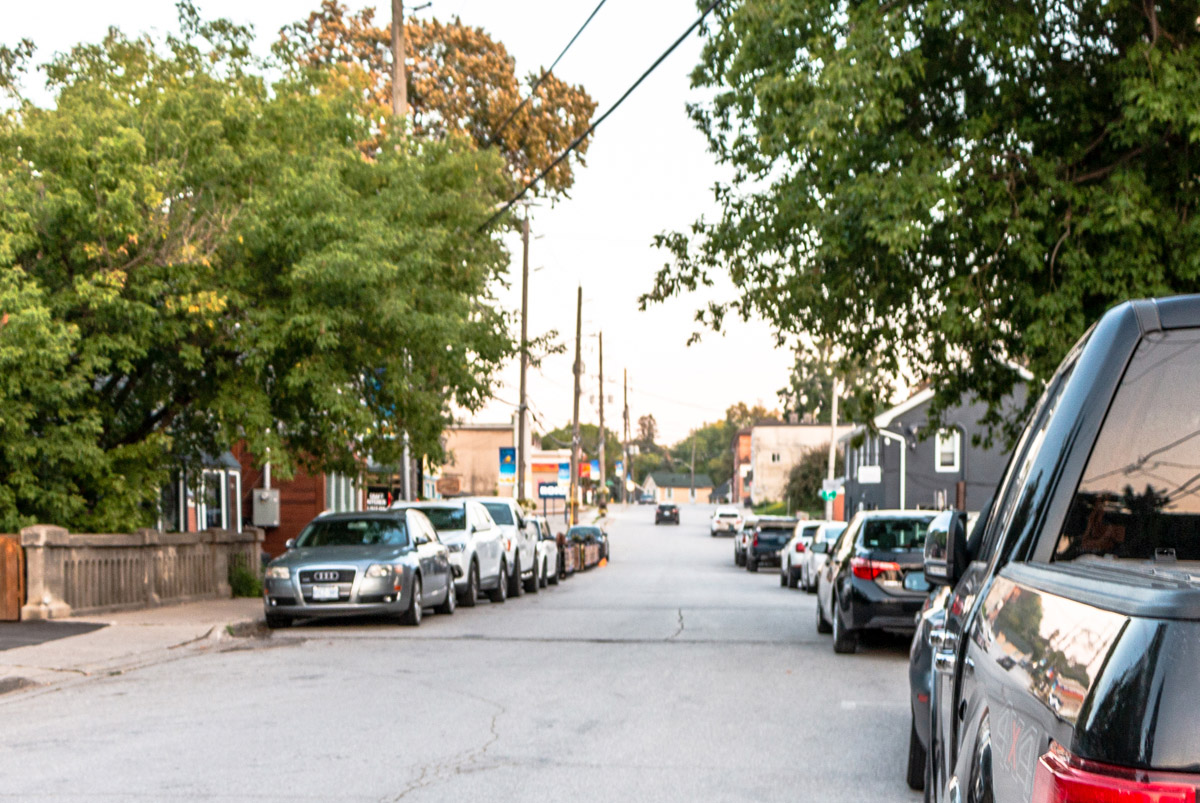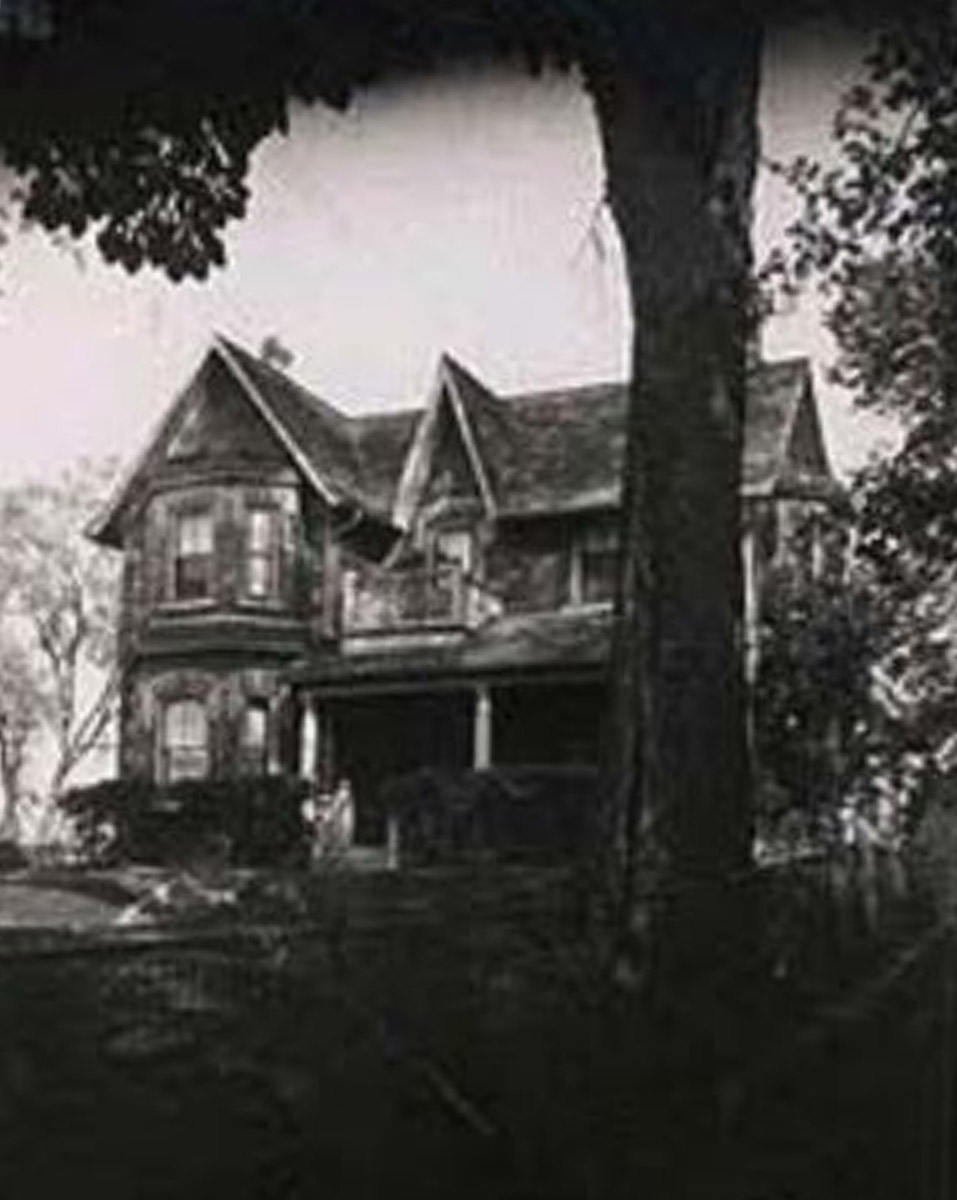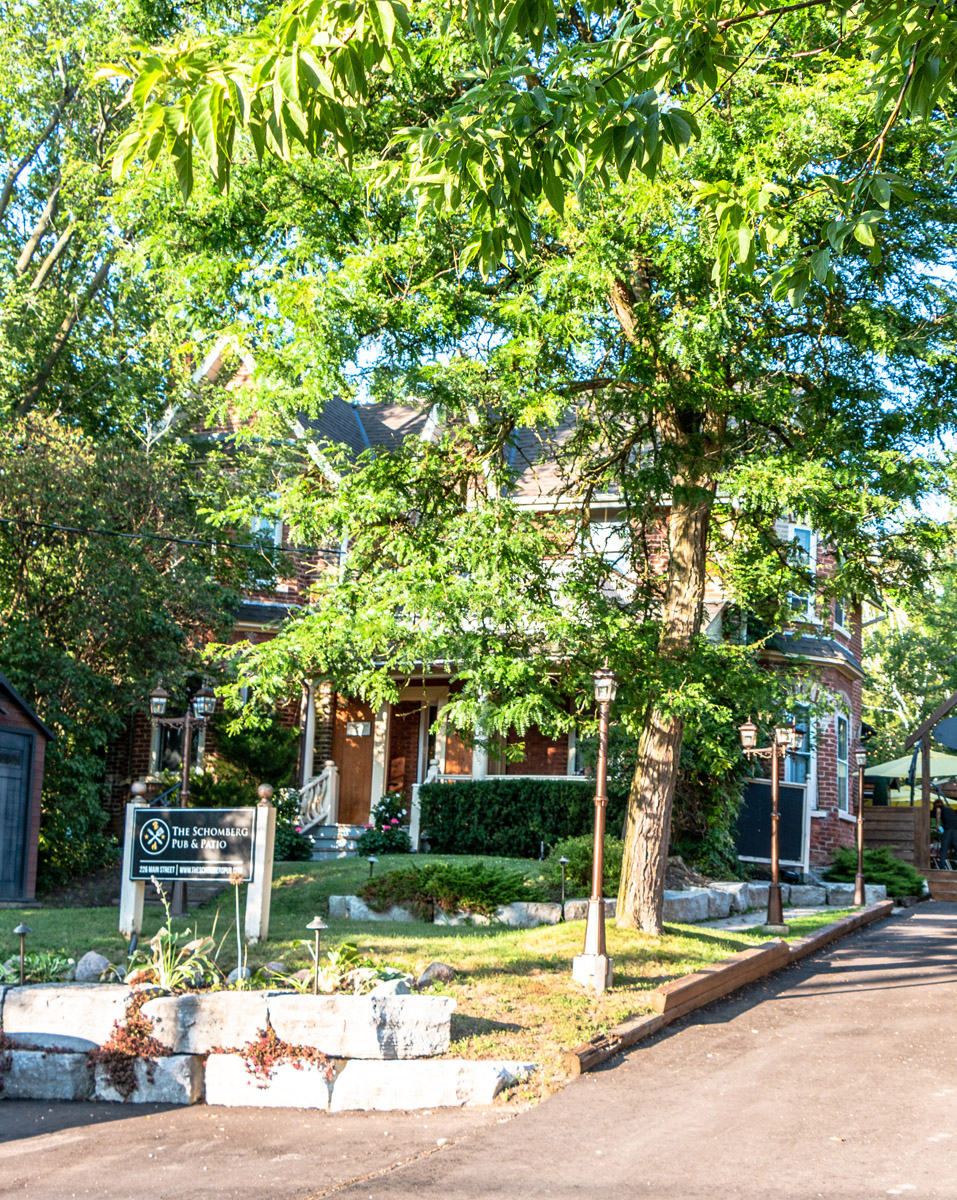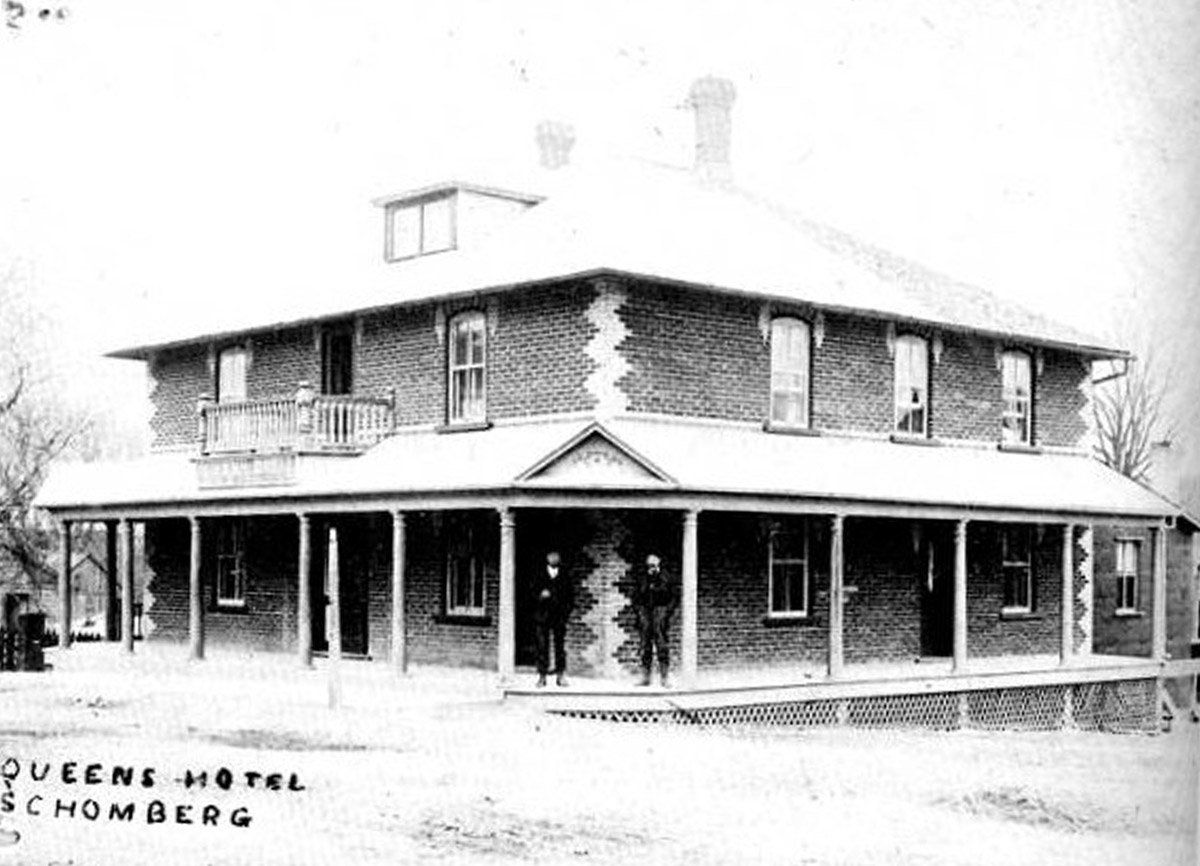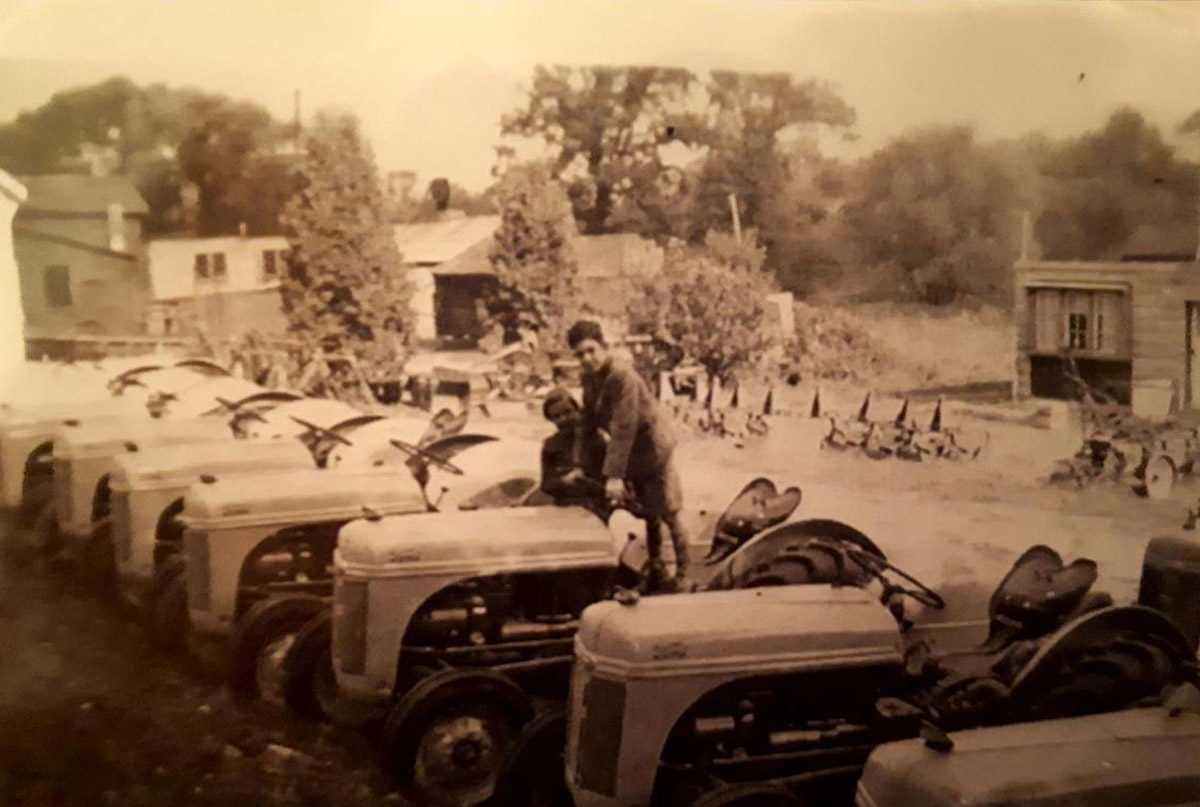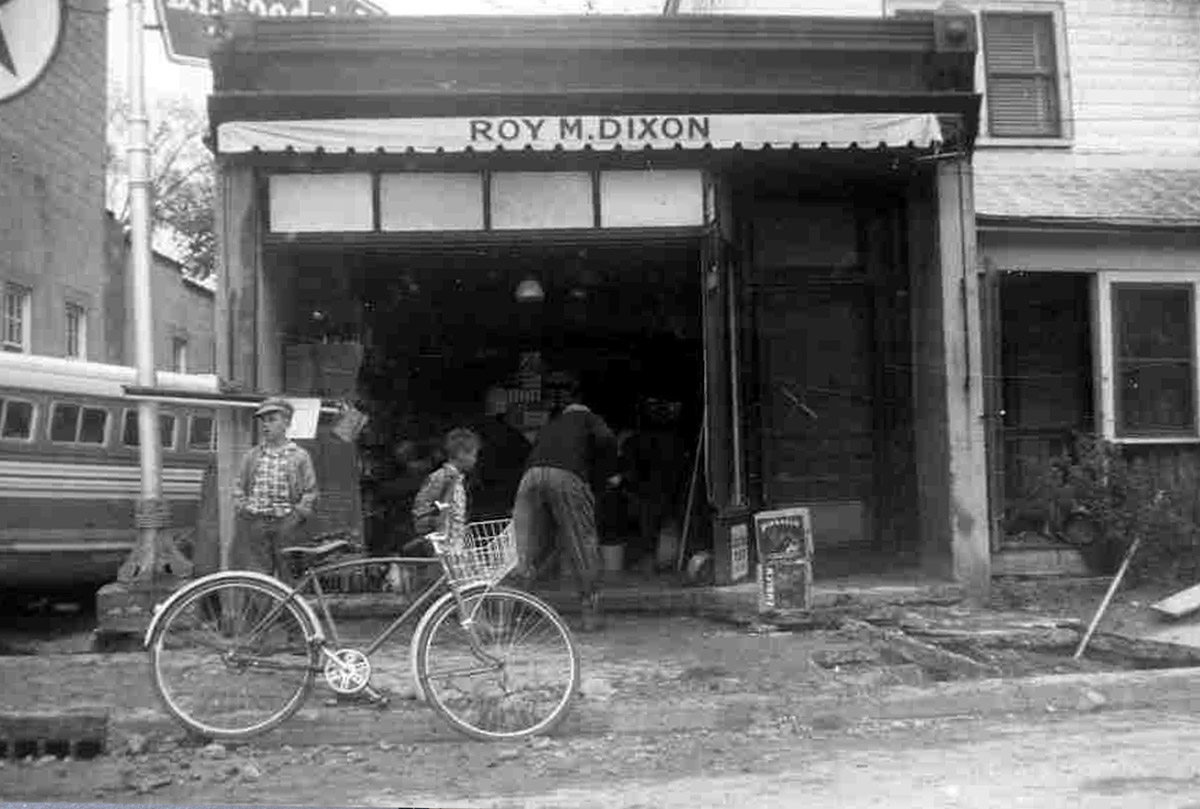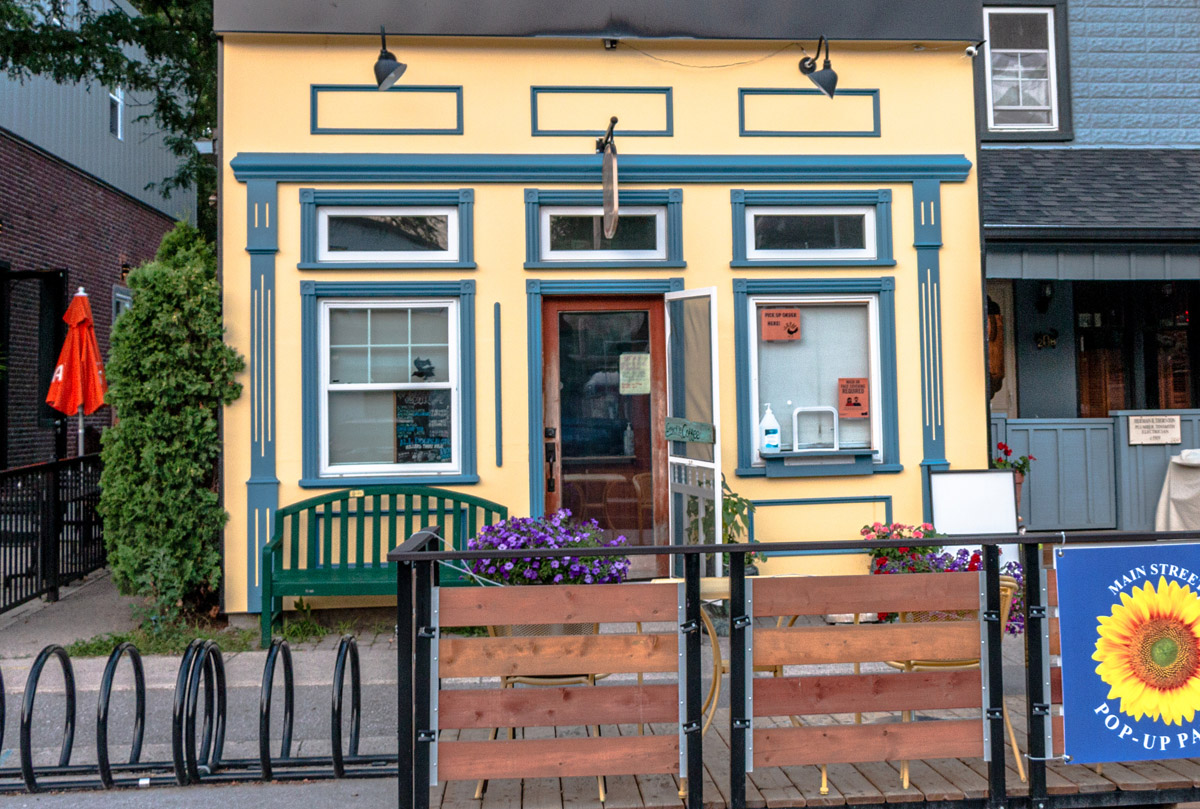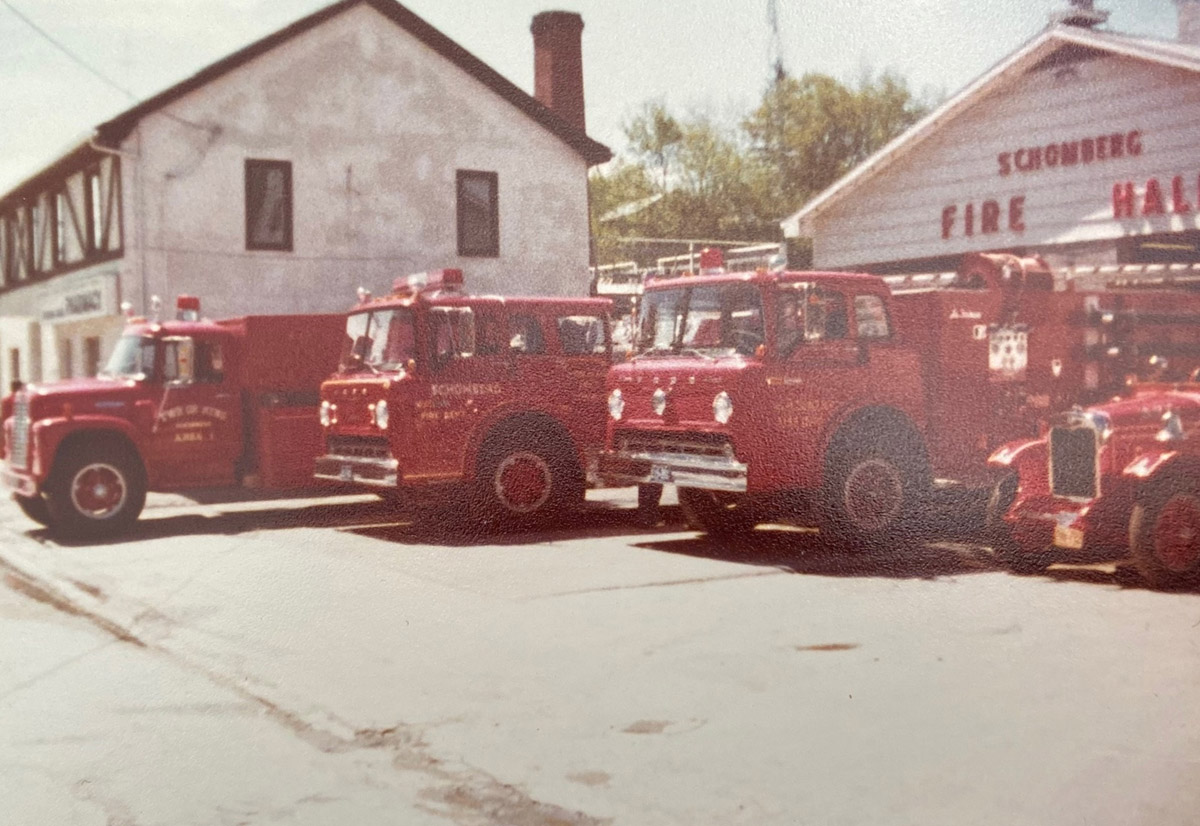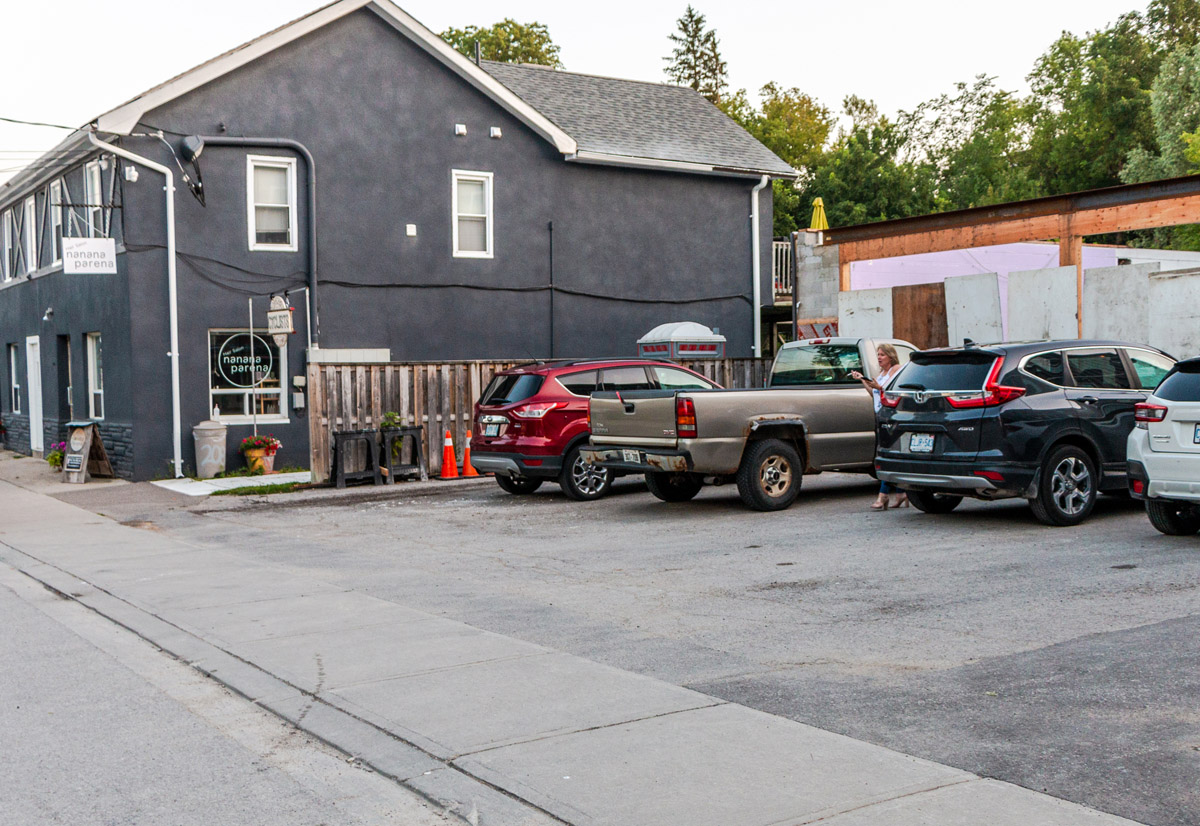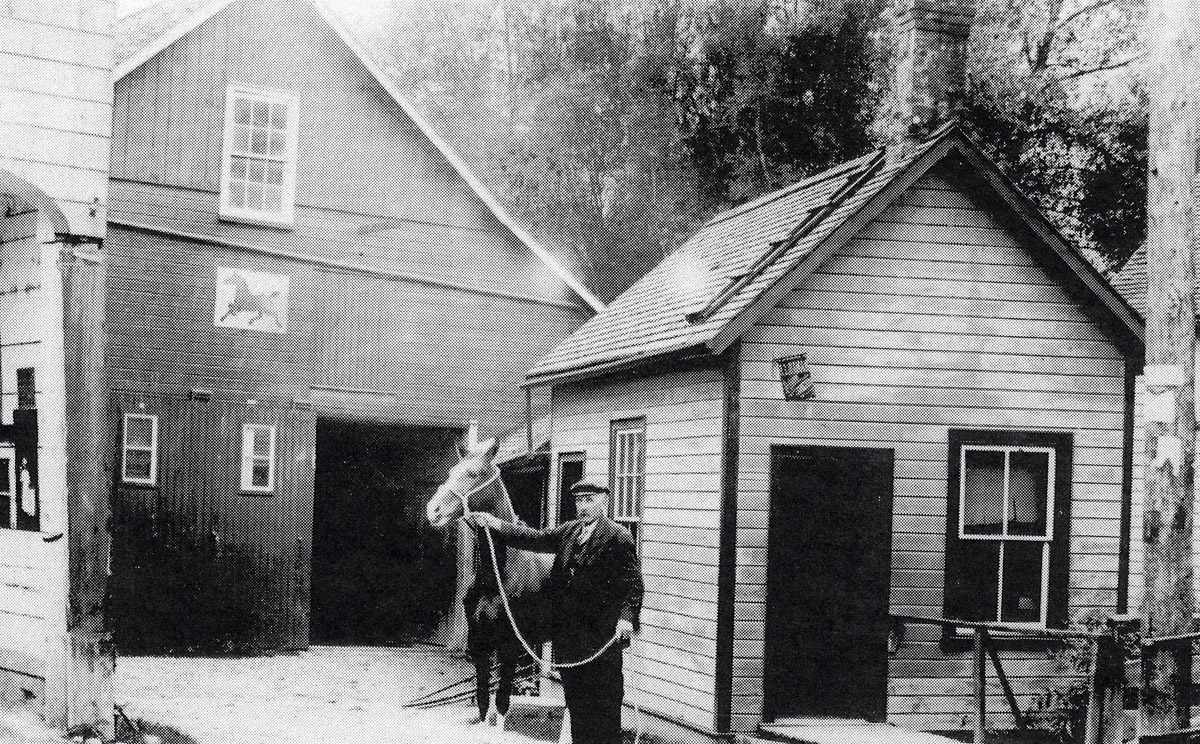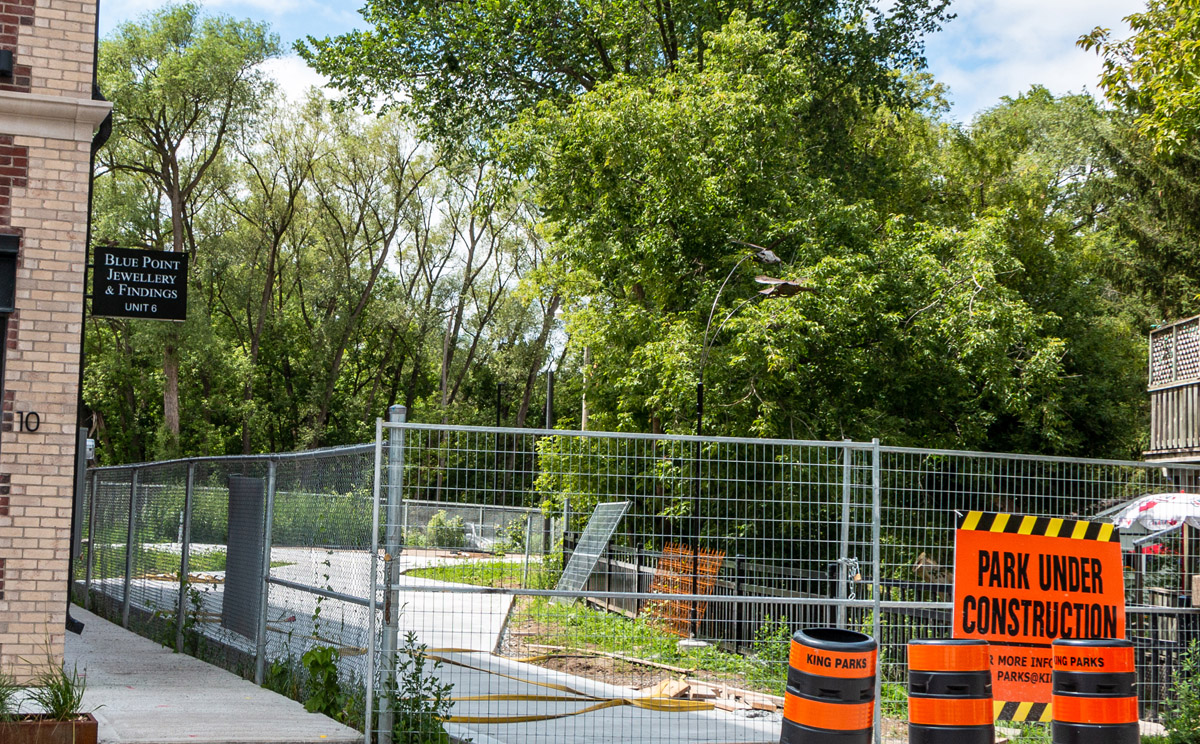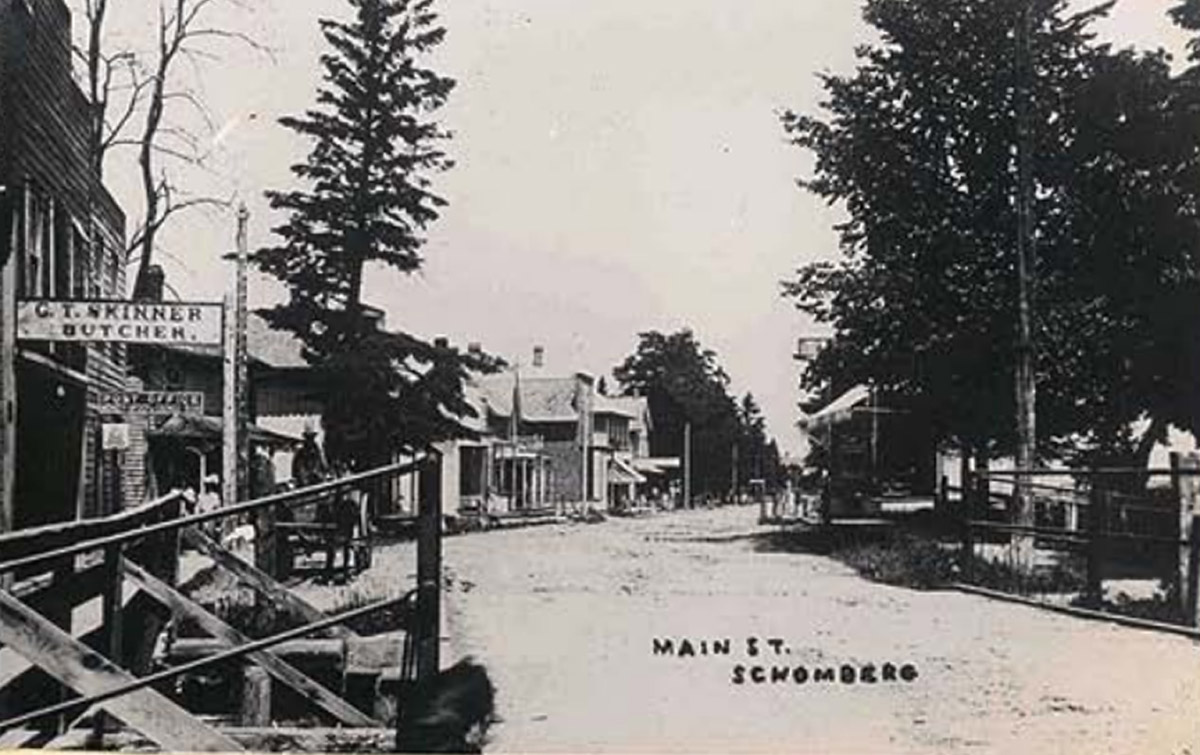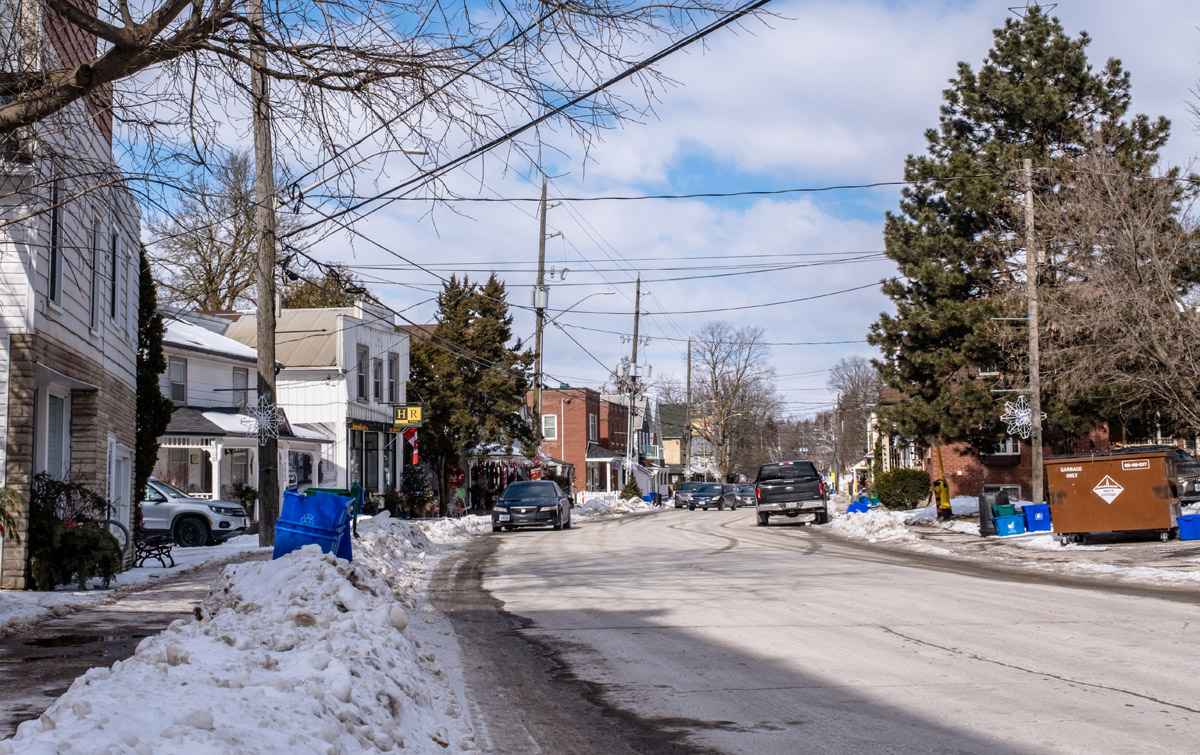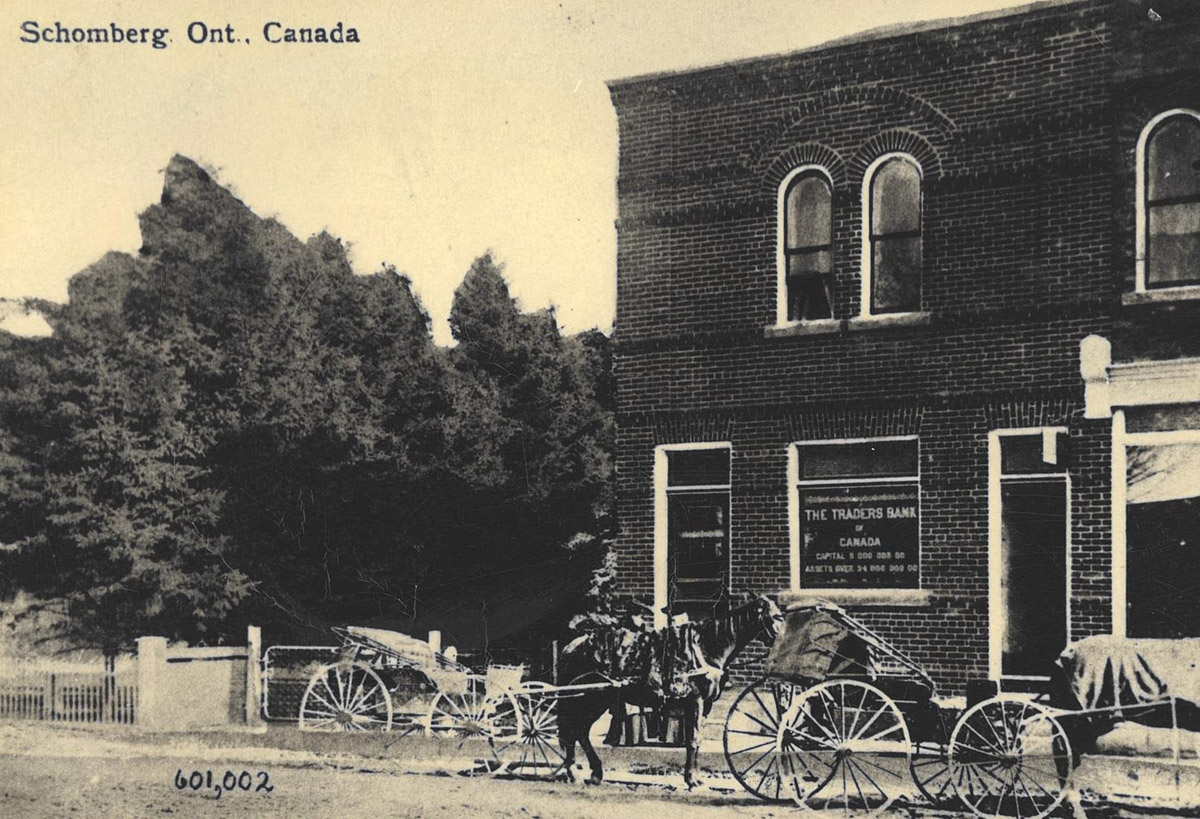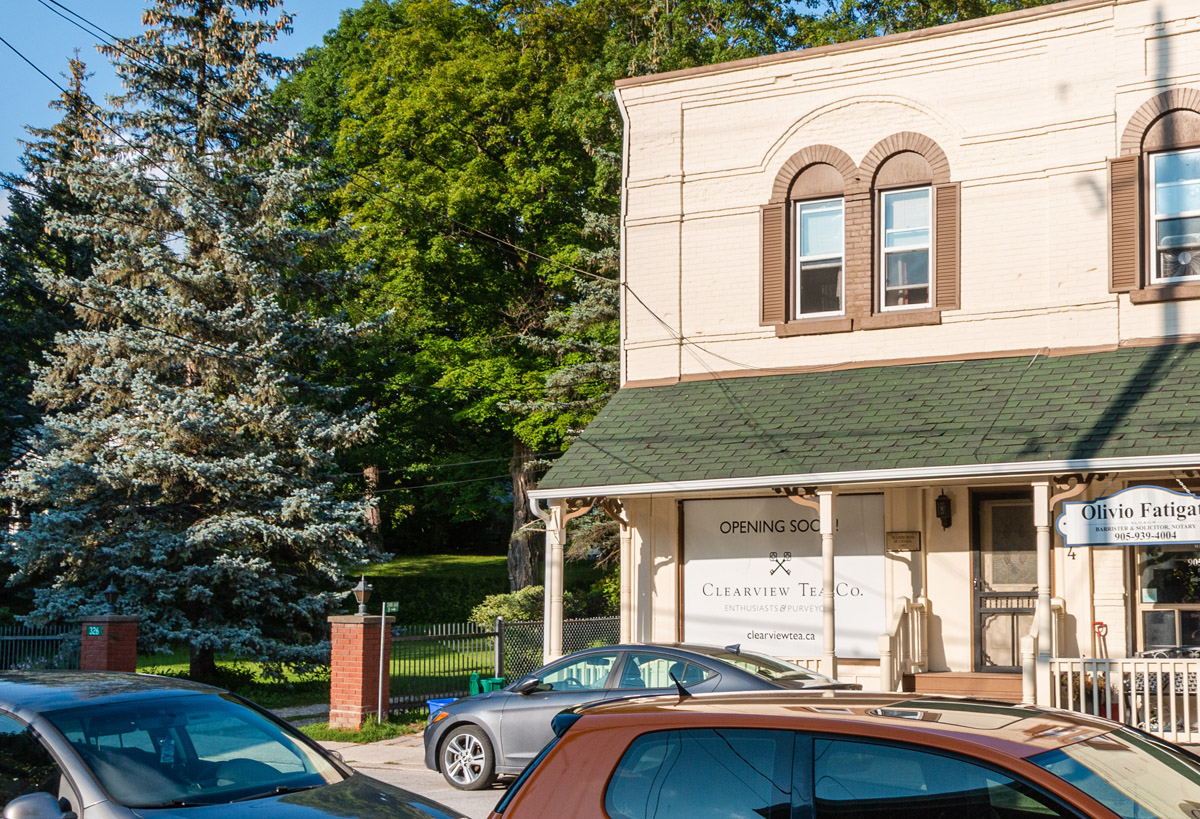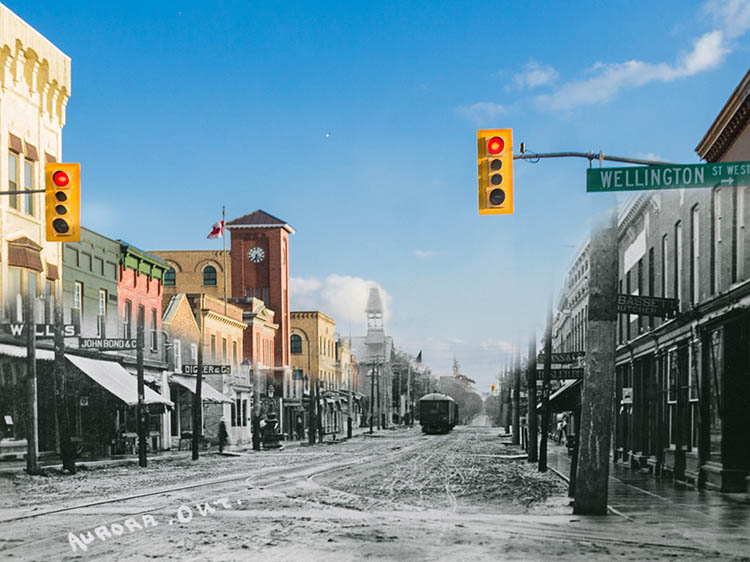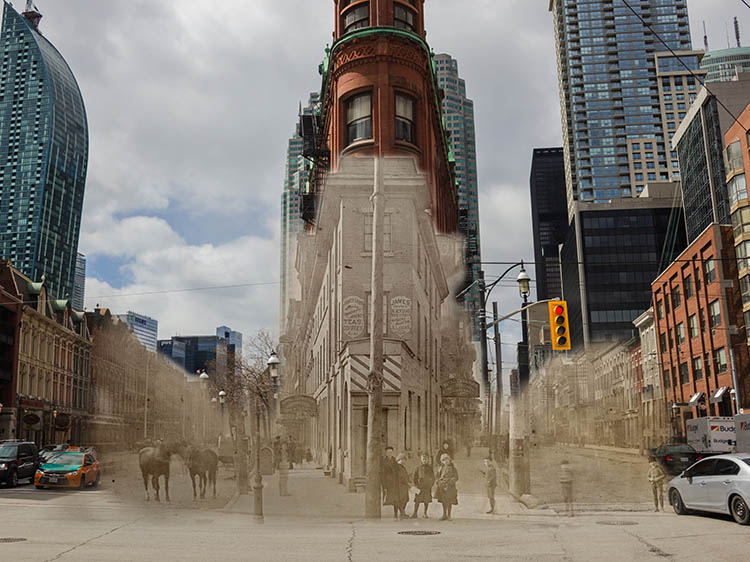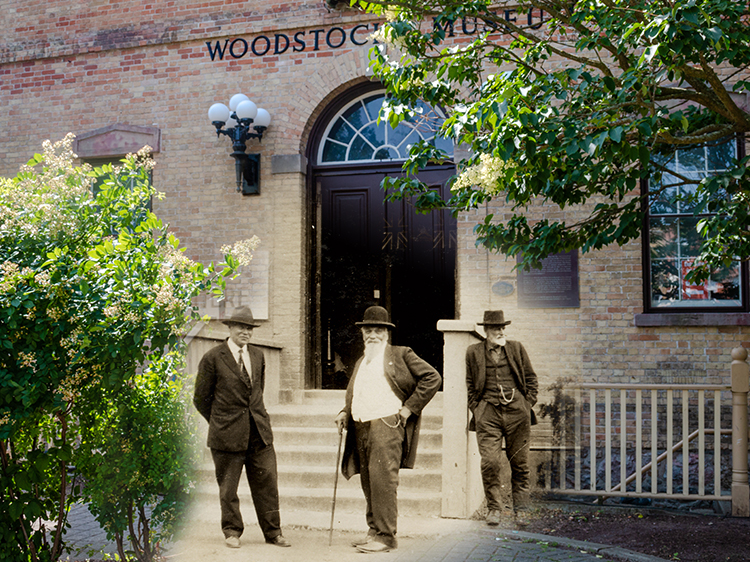Walking Tour
Exploring Schomberg's Main Street
Where the Past is Present
By King Heritage & Cultural Centre and On This Spot
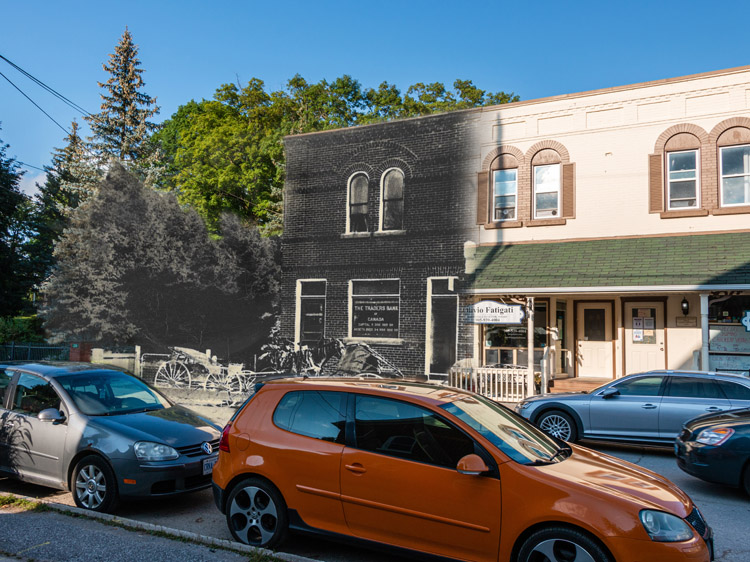
King Heritage & Cultural Centre
When looking at the history of any small town across Canada, its architecture, records, and eyewitness accounts only scratch the surface of the heritage of the communities that have called it home. The earliest evidence of people in Schomberg and the surrounding area dates back 10,000 years. The area was home to the Anishinaabeg, Huron-Wendat, Petun, Mississaugas of the Credit, and Haudenosaunee peoples.
In the 1830s, Quaker settlers founded the agricultural community of Brownsville. For many decades Brownsville was a trading centre, boasting a flour mill, blacksmith, tinsmith and various merchants. With the opening of its first post office in 1862 the village was renamed Schomberg to avoid confusion with another Brownsville located in nearby Vaughan.
Over the years expansion, population growth, fires and floods have altered the look of Schomberg’s Historic Main Street. Modern businesses inhabit the historic brick buildings along a well-lit street. Now a thriving community that blends heritage with modern amenities, Schomberg is a vibrant place to live, visit, dine and shop.
The tour would not have been possible without the assistance of Bill Foran, Linda Jessop, Chief Jim Wall, George Burt, Jeff Hank, Terry Maynard, Gary Maynard, Tony Ouwendyk, Wendy-Sue Bishop, Geoffrey Aitchison, Alex Milani, Sandra Creighton, Daniel McConnachie, the Remember Schomberg group as well as countless other Schomberg residents.
Route
The tour starts and ends at the fairgrounds, home of the Schomberg Agricultural Fair since the 19th century. Free parking is available. As you follow the tour, be sure to also check out the 'Nearby Stops' section for more interesting stories about Schomberg and the area.
From the fairgrounds, walk east on Western Avenue to Main Street and cross to the east side. Stop at the intersection of Main Street and Dr. Kay Drive where you’ll learn about the history of the Schomberg & Aurora Railway and the Schomberg Feedmill.
Then continue walking south on Main Street and discover the historic community hall and more stories about Schomberg.
As you stroll along, take a moment to reflect on early Indigenous communities and how this land has changed.
At your next stop you’ll learn about Doctor Dilliane and his service to the community. Further south, near the corner of Church Street and Main Street, the theme is all about hotels and tractors; then cross to the west side of the street and head back north.
Walking north, take in the history of Hurricane Hazel and other disasters that changed this village; learn about one of Schomberg's vets and the growth of shops and services.
The tour concludes at the community hall, looking across the street to the Trader’s Bank building, the first official bank branch in Schomberg.
This project is possible through the generous support of the Township of King and is funded by Digital Main Street/FutureProof Lab.
1. A Day at the Fair
King Heritage & Cultural Centre
1895
Schomberg's annual spring fair is a longstanding community event that evolved from an agricultural fair first held in the mid-19th century.
* * *
The event, which brought farmers together for friendly competition and drew crowds from miles around, was a regular feature in local and provincial newspapers. The October 8th, 1926 issue of the Globe and Mail reported the exceptional turnout for the Schomberg Agricultural Fair:
"Exhibits, from apple pies, pickles, and livestock to picturesque oil paintings attracted some 4,000 people to what has proved one of the most successful fairs in the history of Schomberg, the event being held yesterday in the local hall. While the tempting dainties claimed hosts of feminine admirers, the men were prone to linger away and discuss the merits of livestock. Both sexes unanimously claimed the outstanding merits of the oil paintings, the work of Bernard Sutton, a mere youngster, who handles the brush with more than average skill, having proved the subject of much comment." 1
Agricultural fairs played a large role in small agricultural communities throughout the history of Ontario. The first Agricultural Society in Ontario was established in 1792 in Niagara-on-the-Lake. In the 1850s, the Ontario Government, appreciating the value of these fairs, began to offer sponsorship to other agricultural and horticultural societies and similar interest groups to encourage more communities to work together to support local farmers and boost their economies.2
The much-loved Schomberg Agricultural Fair was held every fall until 1956, when the Society decided to move the event to the spring. With the exception of 2020 and 2021, when the Fair was cancelled amidst a global pandemic, the fair has continued every year. Held on the last weekend of May, the Fair today boasts a variety of sights and stalls for locals and visitors alike.
2. All Aboard!
King Heritage & Cultural Centre
1908
The first steam train in Canada came through King Township on its way from Toronto to Aurora in 1853. After that, “railway mania” hit Canada and thousands of kilometres of track was laid across the country. For many small communities, a train coming through town was the difference between thriving and fading away.
* * *
As a minor line, the Schomberg & Aurora Railway only had four stations: Schomberg, Aurora, King City and Kettleby with a number of "whistle stops" along the way--small communities where the train would only stop if it was waved down.
Like much of Toronto's Metropolitan Line, the Schomberg & Aurora Railway brought the big city to the small town and vice versa. For locals, the train meant efficient travel directly to downtown Toronto, where they could work, sell goods or go shopping. Likewise, Torontonians could head to Schomberg, shop at the farmer's markets and enjoy an escape from the city. A timetable from 1904 notes that the train ran both ways six times a day, from early in the morning to later in the evening, to serve both daytrippers and commuters.1
On September 3rd, 1902, the Newmarket Era described jubilant scenes at Schomberg when the railway was completed:
"Last Friday was a notable day in the history of this thriving village, when the last spike of the Schomberg & Aurora Railway was driven by Mrs. Shelton, one of the oldest residents of the place, amidst general rejoicing. The school had a half holiday and interested ones for miles around came to the village. The first train to arrive was composed of an engine and seven flat cars. Warden Normal of York, J. W. Moyes, and County Engineer McDougall made speeches. Everybody was invited to get on board and were given a free ride to Yonge St. and back. It is hoped that passenger cars will be running at once, reducing the time of travel to Toronto from 5 hours to 1½ hours."2
The railway line ran for 25 years, until 1927, when it became obsolete. Trucks proved to be more efficient for agriculture by picking up produce and livestock right at the source and removing the need for reloading from truck to train and back again. Passenger service also declined as cars became more popular and bus service to smaller communities expanded.
3. Feeding Farms
King Heritage & Cultural Centre
ca. 1910
One unavoidable cost of farming is animal feed and one way to reduce that cost is through the reuse of crop waste. Anderson Tegart sought to capitalize on the abundant waste found throughout King Township's lush farmland by transforming it into something that farmers could use and also make a tidy sum. Buying land in 1859, he constructed the feedmill in 1870.
* * *
When Tegart purchased the land and constructed the mill, it was at a time when feedmills were rapidly appearing all across North America. By the 1870s, production of animal feed was not only becoming increasingly standardized but was also a hot commodity on the market. Farmers relied on the feed for their livestock and also for the animals who hauled their produce to market.2
This mill enjoyed additional success with the opening of the Schomberg & Aurora Railway. Tegart was able to sell grain directly to large-scale farmers who were much farther away at significantly lower cost. The feedmill continued to flourish until the railroad's closure in 1927.
The mill is one of Schomberg's many original buildings, and its latest owners have managed to retain much of its original look and feel while catering to modern businesses. In 2021, it houses the Scruffy Duck pub, The Scottish Nook, and The Olde Mill Art Gallery & Shoppe.
4. Market on the Move
King Heritage & Cultural Centre
ca. 1880s
When railways arrived in Upper Canada (Ontario) in the mid-19th century, a competition between small communities began; the railway was new and exciting, and all the villages wanted a station. Inclusion on a railway line could ensure the future existence of a village, while being left out almost guaranteed its demise.
* * *
In 1907, the Schomberg Market Association was formed and a new building was purchased. The market had become so popular that on busy days some farmers had to use the agricultural grounds to sell their wares. A special market train on Wednesdays brought more buyers to town and allowed them to make the trip within one day. Local merchants also enjoyed the benefit of the weekly influx of shoppers that came to the village. In 1929, long-time resident Mr. Charles Davis, reminisced about what the town was like in the early days:
"Beside the grist mill, the town at [the] time, about 1850, as near as I can recollect, boasted of two general stores, one liquor store, one tavern now called hotel, one blacksmith shop, one wagon shop, one harness shop, two shoe shops, one tannery, and with about twenty-five or thirty dwelling-houses, and a population of probably one hundred and twenty-five people."1
By the early 1900s, the town had further evolved. The Schomberg Telephone Company Ltd. was founded in 1910 and, in 1927, a new schoolhouse was built to house Schomberg's rapidly growing population. With four classrooms and a science room, as well as two playrooms, the school was one of the grandest in King Township for its time. By 1928, the population of Schomberg was around 350, with a paved main street and numerous businesses, including six grocers. The little village, while slowing down, showed no signs of vanishing like the many ghost towns in the surrounding region.2
5. Community and the Women's Institute
ca. 1907 - 1920
In 1907, the Schomberg Market Association was formed and built the new location you see in the picture above. As times changed, and rail service was discontinued the market's popularity waned, and the hall was converted into a multi-use community hub, housing the Lions Club and the Women's Institute, acting as a true community hall. While community halls across the country have played a similar role, the Women's Institute and their documents are important to the history of Ontario. The Women's Institute preserved the history of its residents in the Tweedsmuir documents, an invaluable record of the comings and goings in Schomberg.
* * *
Another vital community role they fulfilled was the creation of the Tweedsmuir History of Schomberg.2 Tweedsmuir histories can be found throughout the small towns of Southern Ontario. They captured the stories, memories, and lives of the community. While recorded history has always been about important events, the Tweedsmuir histories provide a glimpse at women's everyday lives and important community moments.
The Tweedsmuir History of Schomberg was written in 1958 by the historical committee of the Women's Institute. Found today online at the King Township Public Library, Schomberg's histories cover not only notable families, but the history of schools, industries, and activities of its residents, along with important historical notes. They are some of the most comprehensive books on the lives of early Schomberg residents.
For example, From the recollections of Mabel Skinner, daughter of early Schomberg butcher, George Skinner, we learn that the community came together to pass a law of prohibition in 1905. Notably, Mabel remembered an upswing in her father’s business after the sale and production of liquor was made illegal, with her father commenting that people now had money to spend on proper goods.3
6. Our Old Buildings
ca. 1910s
Preservation of the natural environment and built heritage is a top priority in King and that effort can be seen throughout the Township. In Schomberg, the distinctive charm of the village is provided in large part by the heritage buildings that still line Main Street; preserved not as time capsules but as living buildings that acquire more character with each passing decade.
* * *
Number 284 Main Street first housed a jewellery shop owned by Joseph Butler, and in the 1980s, it was a diner called the King’s Restaurant. Further south, number 272 was originally owned by Sidney Leonard, general merchant, and by the 1980s was a store called Handy-Mart.
Other historical buildings in Schomberg include a house at 66 Main Street, also called the Coburn home. In 2017, the residents of Schomberg petitioned the Township and the Ontario Heritage Trust to have the building designated as a heritage home to save it from destruction via development. Built in 1903, it is one of few remaining historical homes of the period in Schomberg and captures the architecture in Ontario at the time. The home has a mixture of Queen Anne and Italianate architecture not found elsewhere in King Township. It has two verandas and ample space. Originally, it was the home of Joseph Hollingshead, whose father immigrated to Schomberg after the American Revolutionary War in 1778. Joseph was one of Schomberg's local druggists in the 1880s. As a designated heritage building, the Coburn home will be preserved as a Schomberg landmark, due largely to the hard work of Schomberg citizens.
Just outside of Schomberg is one of its oldest features, the Society of Religious Friends cemetery and its associated Union Church. Found at 27000 Highway 27, the church was constructed by Schomberg's early residents in 1813. The cemetery was later built in 1833, and what began as a Society of Religious Friends cemetery eventually became non-denominational. Quakers, or, more properly, the Society of Religious Friends, arrived in Canada in the 18th century from the United States and in the 19th century from Ireland and England. Quakers are pacifists with strong sentiments and religious doctrines against violence, slavery, and capital punishment as well as deeply rooted views on the equality of the genders. Quakers in 18th- and 19th-century Canada were quietists who withdrew from Western society as it did not share many of their beliefs. By the 19th century, different variations of the Society of Religious Friends had developed, and different practices could be found throughout Southern Ontario, some more outwardly vocal than others.1 The Browns brothers, who were among the first settlers of Schomberg, were Quakers from Pennsylvania. The Lloyds who helped shape nearby Lloydstown were also Quakers.2
The task of preserving and promoting King’s history lies with the King Heritage & Cultural Centre (KHCC). Working alongside cultural organizations such as Arts Society King (ASK) and the King Township Historical Society (KTHS), the Centre promotes history and culture across the Township; signage, exhibits, and programs all strive to take history beyond the walls of the centre and into King communities.
7. Changing Face of Main
King Heritage & Cultural Centre
ca. 1940s
The face of Main Street has changed over the last century, but its heritage still shines through. New residents arrived and established businesses and others moved away. On the east side of Main Street, just over the bridge the building at 220 Main Street, was home to Charlie’s Barber Shop. Next door at 214 Main Street, an Imperial sign marks the location of a former garage.
* * *
Just past the bridge on the west side of the street, the light-coloured building at number 203 was the Schomberg Creamery. Now home to Cottage & Crown, the Creamery was built in 1927 by the enterprising Kaplan family. In 1906, David Kaplan emigrated from Odessa (modern-day Ukraine). He went first to Austria and then to Canada in an attempt to escape the war between Russia and Japan and a second round of military conflict. Kaplan arrived in Toronto with no more than ten dollars after leaving his wife, mother, and children back in Ukraine.
In Toronto, Kaplan spent two years as a successful produce vendor before trying his hand at selling wares. When his wife and children joined him in Canada a few years later, they purchased the Maple Creamery, and he lost nearly every penny he had in the business. The residents of Maple came to his rescue, however, and collectively helped him borrow almost $2,000 - not a small sum for the time. One generous citizen lent him another $500. By 1917, the business's fortunes had recovered and Kaplan repaid the money. The family then moved to Schomberg where they built a creamery. Their business prospered and for decades thereafter the Creamery remained a landmark on Schomberg's Main Street.2
8. The Doctor Is In
King Heritage & Cultural Centre
ca. 1920s
The Schomberg Pub & Patio is housed in this picturesque late-Victorian brick house, once the home and workplace of one of Schomberg’s renowned medical doctors. Morris Kinsey Dillane was born in 1874 near Tottenham, Ontario, and studied medicine at the University of Toronto. In January 1900, Dr. Dillane started his practice in Schomberg, and two years later, he married Annie Henderson. The couple received a driving horse as a wedding gift from Dr. Dillane’s older brother, and it was Old Dolly that ensured the doctor made it through all kinds of weather to his house calls.
* * *
Nowadays, we turn to specialists for a variety of issues. For example, obstetrics and gynecology are involved in childbirth, whereas a general practitioner treats non-invasive and non-specialist illnesses. This was not the case in the early 20th century. Doctor Dillaine, like many others, was one of only a couple of doctors in a large encatchment; he was required to do a little bit of everything. In addition to working for more than 55 years as a doctor, he acted as Associate Coroner for York County for 17 years and Medical Officer of Health for King Township for 11 years.
During his long career he saw many medical innovations, such as the discovery of insulin, one of Canada's greatest medical innovations, and also during some of Canada's greatest struggles: the World Wars, Great Depression, 1918 influenza pandemic, and the long battle against tuberculosis.2
In 1953, a party was held at the Schomberg Fairgrounds in the doctor's honour and was attended by more than 3,000 friends and former patients. Reportedly in attendance were some of the over 5,000 babies that he had delivered during his career. Ever dedicated, the doctor continued to work until his death in 1956.
In the mid-1970s, Dr. Dilliane's old home was purchased by the Andrews Family, who operated it as a bakery called L’Haricot Vert until a gas explosion in 1989. Rebuilding included a tea room and specifications for a liquor licence. In 1994, Dr. Dillane’s Pub & Patio opened and operated until 2011, when the name changed to The Schomberg Pub & Patio, which is still open in 2021.
9. Inn for the Night
King Heritage & Cultural Centre
1908
The historic hotels of Schomberg held an important purpose for the town, not only providing a place for weary travellers to rest but also a place for stabling horses. By the late 19th century, Schomberg had two hotels frequented by locals and travellers alike: the St. George Hotel and the Queen’s Hotel.
* * *
Like the Queen’s Hotel, the St. George Hotel was another early watering hole for the residents and visitors of Schomberg. It had room for about twenty guests and had ample horse sheds. Interestingly, the St. George made national newspaper headlines in 1913 after a local man died in one of its rooms and was not discovered for two days! On New Year's Eve 1913, Thomas Creighton, the local saddler, had been drinking nearby when he wandered into the St. George. Unbeknownst to the owner and receptionist, Creighton commandeered a bed in one of the empty rooms and promptly fell asleep. On New Year's Day, Mrs. Sliney, wife of the proprietor, opened the door and assumed there was a guest asleep. The next day, the son of the owner found Creighton, who had passed away on his first night from heart failure and intoxication.3
With several different proprietors over the course of its history, the St. George was last owned by Mr. E. J. Smith, who purchased it in 1924. Smith was from Birmingham, England, and travelled to Canada with his wife in 1903, where he was a silversmith in Toronto for many years before making his way to Schomberg. 2
This hotel was destroyed by fire in 1929 but may not have survived much longer regardless.. The growth of larger centres and the improvement of transportation led to a decline in the need for accommodation in small communities.
10. The End of an Era
ca. 1940s
Between the 19th and 20th centuries, farming implements changed significantly. Inventions in farming, including the tractor, made life easier for the farmers of Schomberg. More and more farm tools became mechanized, and steam engines in particular made significant changes to the farming landscape. Tractors could complete the same work as horses in hours rather than days. By the 1940s, the era of workhorses was coming to an end.
* * *
From steam-powered to gasoline-powered, the tractor became a necessary tool for the farmers of Schomberg, replacing the horse as the primary tool of farming. Tractors became so critical to Schomberg's farmers that Ford opened a tractor dealership in town, owned by Cecil Maynard.
The transfer from horse to tractor was difficult and farmers would often trade in their animals to purchase one of the new machines, as they could not afford to buy them outright. Terry Maynard recalls, “When Cecil secured the franchise to sell farm tractors he would approach farmers and make them an offer to trade their horses for a tractor. Many farmers were in favour of this trade since they didn't have many dollars to spare. They weren't growing enough crops to save any money. Published records of some trades suggested that a John Deere A-Tractor could be traded for 4 horses."
This photo was taken on Cecil’s land, just south of the CIBC bank building, where Port Soiree restaurant is now located. There was a small block-shaped building and the tractors were displayed out front close to the street.
11. The Wrath of Hazel
King Heritage & Cultural Centre
1954
This photo shows the clean-up at Dixon’s Grocery at 208 Main Street, which is now home to Grackle Coffee, in October of 1954. Like many of the towns in the area, Schomberg faced significant repairs in the wake of Hurricane Hazel, an unprecedented storm that hit the area with a vengeance. What began as a small hurricane near Haiti hit the Carolina coast and moved across Pennsylvania and New York to stall over Southern Ontario. Hazel was responsible for at least 645 deaths across Haiti, the United States, and Canada.
* * *
Communities across Ontario were largely unprepared for the destruction, which was further heightened by the record rainfall that had occurred in the region the previous month, making flooding a serious problem. Some may recall that a few cars were lost during Hazel, washed away down the swollen creek. Amazingly, the vehicles were recovered only a few years ago during dredging of the Holland Marsh River!
As reported by the Aurora Banner on October 21st, 1954, “there was nothing but expressions of thankfulness that no lives had been lost as the usually docile Schomberg Creek, raged in its crazy pattern around churches, stores and residences in the middle of town for ten hours Friday night."
By the time Hazel had passed, the damage was so great that the World Meteorological Organization retired the name from use in North America. No hurricane would ever again be named Hazel, in the hopes that the damage left behind would never be repeated.
12. Bucket Brigade
ca. 1960s
Fires were a common concern throughout the history of North America. The Huron-Wendat built their longhouses in formations that would prevent wind from blowing through and spreading fires. In the 19th century, Toronto declared that all residences must have two two-gallon buckets and two ladders ready in case fire broke out.
Early wooden structures were certainly at the mercy of fires, but water was equally destructive. Schomberg saw its fair share of both; throughout its history, fires and floods have changed the shape of the town and the lives of its residents.1
* * *
Another critical incident was the fire of 1923, which threatened all of Schomberg. On June 15th, a fire broke out at 4am, in either Edward Sibree's general store or the home of Mrs. Hanna Brydon, both located on Main Street. As the flames rose higher and threatened to spread to the nearby buildings the Brydon family was able to make it to safety, but their home could not be spared. It was only through the hasty congregation of an aptly named "bucket brigade" that the complete destruction of the nearby Robert J. Creighton's general store and the home of Michael Murphy was prevented—Schomberg had no formal emergency services at the time.
The fire caused $30,000 in damages (around $500,000 today) and destroyed three other businesses. Residents tried to contact the nearby Newmarket Fire Department for help, but by the time they arrived at 7am, the fire had been safely contained. Residents had used buckets of water from hand-operated pumps to control the blaze.3
In 1929, after yet another series of fires, the town purchased its first fire engine as a way to prevent future destruction. In 1947, the town acquired two more forms of fire protection: a 400-gallon water tank and a large fire siren.4 The addition of a firehall further decreased the likelihood of the widespread destruction of past fires.
13. All Creatures Great and Small
King Heritage & Cultural Centre
ca. 1890s
In an agricultural community, where the health of farm animals was key, the vet was a vital and respected member. Dr. Robert L. Graham (1858-1923) was one of Schomberg's beloved veterinarians; his small shop was located adjacent to the Street George Hotel on the west side of Main Street.
* * *
Trained veterinarians were exceedingly rare and in Canada there were only two schools of veterinary science offering two-year programs, one in Toronto and one in Montreal. Both were highly competitive and drew students from all over North America.2 Dr. Graham was one of these students, receiving his degree from the Ontario Veterinary College in 1895. He was listed as a local from Schomberg.3
By the 1920s, much of veterinary science was managed by the provinces, and the greatest numbers of graduates lived in Ontario, which was likely related to the significant demands for farmland and animal care there. The greatest shift in the treatment of farm animals actually occurred in the 1930s and 1940s when vets became highly invested in healing livestock to increase yields for farmers. Rather than leaving farmers to deal with the fall out from cows who were sick and couldn't produce milk or with having to buy another horse, vets sought to improve livestock health at all stages of life. Thus, veterinary medicine as we know it to be today was born. 4
Dr. Graham was active in the community and was the first president of the Market Association and the Secretary-Treasurer of the Schomberg Agricultural Society.5
14. Serving Schomberg
King Heritage & Cultural Centre
1924
Echoes of the past can be seen in this early 20th century image, which looks north on Main Street. The street was gravelled, the sidewalks wooden and there were hitching posts for the horses. Today the streets are paved, the sidewalks cement and the hitching posts have been replaced by cars lining the street.
In the front left of this photo is Skinner’s Butcher Shop, now a private residence, with its delivery wagon parked out front. George Thomas Skinner started butchering at age 16 and ran a successful business for many years. Skinner's youngest son, Blake, followed in his father's footsteps and carried on the family business.
Mid-ground, partially hidden by a tree in this photo, is a typical board-and-batten commercial building at 239 Main Street. Today it's occupied by Horizon Realty. Originally built as 1 ½ storeys, a cheeky way to avoid higher taxes, buildings like this had false fronts to make them appear a more impressive two storeys. With a central front door and large windows to illuminate the interior and showcase the wares on offer, these stores often had living quarters upstairs for the family who ran the business. Over the years, this building housed many tenants. Today it is remembered fondly as Foran’s Barbershop & Billiards Hall.
* * *
Further along the west side of Main Street, in the background of the modern photo, the squared building at number 283 can be seen. In the late 19th century, this was the home of Jonathan Brydon’s dry goods store and later Ernest Stuckey's drugstore.
Born in Orangeville, Stuckey served in the Canadian Expeditionary Force during the First World War and then returned home to complete an apprenticeship and attend Pharmaceutical College. In 1922, he purchased a drugstore in Schomberg that was destroyed by fire (the building can be seen in the distance in the historic photograph). The following year was more favourable for Stuckey as he rebuilt the drugstore in red brick and married Dora Lockhart of North Bay. Schomberg Pharmacy served the community for many years.
15. Cashing In
King Heritage & Cultural Centre
ca. 1902-1915
While the first official commercial bank branch to open in Schomberg was the Traders Bank of Canada in 1902, the first actual bank in Schomberg was Garrett Brown's private bank. In 1865, Garrett Brown opened a private banking firm, largely a lending institution with high interest rates, in his own home at the corner of Main Street and Church Street.
Banking at the time was monitored by charters issued by the government of Upper Canada by royal assent. Businesses that received and held deposits for the public were considered banks, and legislation was developed to discourage private banking. However, rural communities often did not have the benefit of chartered bank branches, so prominent citizens would step in to fulfill this need.1
* * *
The former Traders Bank building was merged with an adjacent building and now houses a number of modern businesses including Schomberg Quality Meats, Olivio Fatigati, Barrister & Solicitor and Eddy’s on Main.
From its humble origins as the tiny village of Brownsville in 1830, to its transformation into a booming trading centre by 1895, Schomberg grew significantly in its first 65 years. In the early 20th century, Schomberg gained a connection to Toronto with the arrival of the Schomberg & Aurora Railway and the weekly market boomed.
During the first half of the 20th century, Schomberg saw growth and prosperity, even against the challenges of two World Wars and the Great Depression. Even as other villages faded away, Schomberg thrived. Through the decades, the Women's Institute, the Lions Club, the Masons, and the Agricultural Society helped foster a strong community spirit. Events like the annual agricultural fair are a testament to community spirit and the character of Schomberg residents.
Located off the beaten track in King Township, this hidden gem of a village is a perfect blend of old and new. While the past is well preserved, the future of Schomberg is bright and hopeful, much like its residents after the destruction of Hurricane Hazel. From the Tweedsmuir history of Schomberg: the town and its residents "treasure the past and face the future."2
Endnotes
1. A Day at the Fair
1. Special Despatch to, The Globe. 1926. "SPLENDID EXHIBITS AT SCHOMBERG FAIR: MORE THAN FOUR THOUSAND PEOPLE ATTEND ANNUAL EVENT." The Globe (1844-1936), Oct 08, 13.
2. Archives of Ontario.Exhibit: Celebrating Our Agricultural Past.Online http://www.archives.gov.on.ca/en/explore/online/agriculture/strength.aspx
2. All Aboard!
1. Metropolitan Railway Company, T., Schomberg & Aurora Railway Company. (1904). Bond Lake and the highlands of York, Thornhill, Richmond Hill, Aurora, Newmarket, and intermediate points, via the Metropolitan Railway Co., and Bond Lake to Schomberg via the Schomberg & Aurora Ry Co: guide and time table. Toronto: Bryan Publishing..https://babel.hathitrust.org/cgi/pt?id=aeu.ark:/13960/t6p000122&view=1up&seq=28
2. https://railwaypages.com/schomberg-aurora-railway.
3. "METROPOLITIAN PURCHASE: TORONTO RAILWAY SAID TO HAVE SECURED CONTROL HAS THE END OF LONG-PENDING NEGOTATIONS BEEN REACHED: WORK ON THE Schomberg & Aurora EXTENSION GOING ON-- IMPORTANT FEEDER TO THE TORONTO RAILWAY." 1901.The Globe (1844-1936), Aug 05, 3.
3. Feeding Farms
1. Coffey, D., Dawson, K., Ferket, P. and Connolly, A., 2016. Review of the feed industry from a historical perspective and implications for its future. Journal of Applied Animal Nutrition, 4.
2. Coffey et al., 4
4. Market on the Move
1. Sawdon, H. 1928. Schomberg and Its School, S.S. No 14, King. Ryerson Press, pp.11.
2. Sawdon, H. 1928. Pp. 23
5. Community and the Women's Institute
1. Federated Women's Institute. 2020. Our History. Online
2. History of Schomberg's Women's Institute, Part 1, 1911-1958. Online.
3. Schomberg Tweedsmuir Histories. 1911-1958. Farm and Family Memories, Part 2.
6. Our Old Buildings
1. Newlands, David L.Quakers. The Canadian Encyclopedia. Historica Canada. 2006.
2. Gillham, Elizabeth. 1975. Early Settlements of King Township. King Township, pp. 33
7. Changing Face of Main
1. Goad, CE. 1904. Fire Insurance Map of Schomberg. Canadian Fire Insurance Maps, McMaster University. Online.
2. Sawdon, H. 1928.
8. The Doctor Is In
1. Shortt, S.E.D., 1976. The Family Doctor in Canada, 1900-1951. Canadian Family Physician, 22, p.51.
2. Shortt, 51.
3. Shortt, 51.
9. Inn for the Night
1.Sawdon, H. 1928. Schomberg and It's School (S.S.14, King). Toronto: Ryerson Publishers.
2.Sawdon, H. 1928.
3. Schomberg Man Found Dead in Hotel Room. January 9th, 1913. The Globe and Mail. Online
10. The End of an Era
1. Hamre, B. Asselstine, A. 2015. Agricultural Implements. The Canadian Encyclopedia. Online.
11. The Wrath of Hazel
1. Sunshine Salves Wounds of Flood. October 22, 1954. The Vancouver Province. Online
2. Marsh, J. 2012. Hurricane Hazel. The Canadian Encyclopedia, Online.
12. Bucket Brigade
1. Canadian Fire Museum. History of Canadian Fire Fighting from 1800 to 1900, the Development of Machinery. http://www.firemuseumcanada.com/history/history-1700-to-1800/
2.Sawdon, H. 1928. Schomberg and It's School (S.S.14, King). Toronto: Ryerson Publishers.
3. Fire at Schomberg Cuts 30,000 Swath. June 16, 1923. The Globe and Mail. Online
4. Fire Siren Solo to be Feature of Dance for Smoke Eaters. April 12, 1947. The Globe and Mail. Online.
13. All Creatures Great and Small
1. Hayter, E.W., 1960. Livestock Doctors, 1850-1890: The Development of Veterinary Surgery. The Wisconsin Magazine of History, pp.159-172.
2. Barker, A. 2013. History of Veterinary Medicine. Canadian Encyclopedia. Online
3. A Batch of Vets: 150 to Receive Their Diplomas. March 30, 1985. The Globe and Mail. Online
4. Barker, A. 2013. History of Veterinary Medicine. Canadian Encyclopedia. Online
5. Sawdon, H. 1928. Schomberg and its School (S.S. 14 King). Toronto: Ryerson Publishing.
15. Cashing In
1. Breckenridge, Roeliff Morton. The Canadian banking system 1817-1890. Vol. 10, no. 1-3. Publishing by Macmillan, 1895.pg 55
2. Tweedsmuir History. 1958. Schomberg - Introduction. Online




